Welcome to Tire School!
We're going to have a crash course (figuratively speaking!) on motorcycle tires. This is literally where the rubber meets the road.
At RevZilla, we deal with a vast spectrum of customers, from sponsored racers on rockets to green rookies on Ninja 250s, to someone pushing hundreds of miles daily on a Harley bagger — and that’s just the street riders! One thing they all have in common is that tires are critical components.
Like with most of the products we sell, making a good decision when choosing tires is a matter of understanding how you ride, being honest about your intents and abilities, and most importantly, being safe. Let’s start with a quick run-down of tire terminology.
 A small part of the tire, it is vitally important. It gives the tire much of its handling and load transfer characteristics. This is the part of the tire we’re talking about when we reference height, profile, or aspect ratio. Typically, a shorter sidewall yields a stiffer sidewall, which tends to flex less. To a rider, this means better handling and turning, worse bump absorption, and more difficult mounting. This section greatly contributes to the tire’s role in the suspension. That’s right — the tire is a suspension component!
A small part of the tire, it is vitally important. It gives the tire much of its handling and load transfer characteristics. This is the part of the tire we’re talking about when we reference height, profile, or aspect ratio. Typically, a shorter sidewall yields a stiffer sidewall, which tends to flex less. To a rider, this means better handling and turning, worse bump absorption, and more difficult mounting. This section greatly contributes to the tire’s role in the suspension. That’s right — the tire is a suspension component!How do you know the important stuff about a tire? Like, what’s inside it and what size it is? It's easy. By law, this information is written on the tire sidewall.
There are two ways to give tire information: alphanumeric and metric.
A quick history lesson before we start decoding: In the old days, there was only one way to size tires — alphanumeric. Radial tires didn’t exist, so there were a pretty limited number of sizes available, which made an uncomplicated system adequate.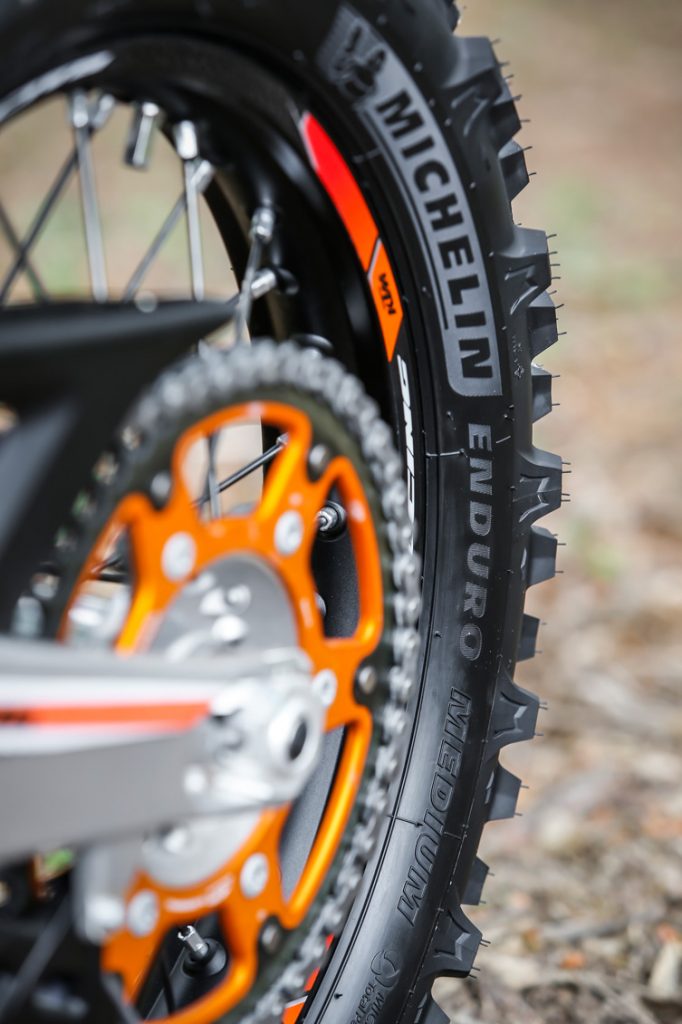 As increasingly complex tire technology became available, it was evident a new system needed to be cooked up to provide that information to consumers and sellers, so the metric system was developed. In the days of yore, tires never really got bigger than six inches across the tread (or from rim to tire edge), too, so if a tire has a size of much larger than 150, it will never be in an alphanumeric size, because they didn’t exist in the Dark Ages of motorcycling. Don’t be scared off by alphanumeric tire sizes – it’s usually easy to get a great tire that will make you happy, and in a tiny way, you’ll be using a tire that connects you to the old days of motorcycling.
As increasingly complex tire technology became available, it was evident a new system needed to be cooked up to provide that information to consumers and sellers, so the metric system was developed. In the days of yore, tires never really got bigger than six inches across the tread (or from rim to tire edge), too, so if a tire has a size of much larger than 150, it will never be in an alphanumeric size, because they didn’t exist in the Dark Ages of motorcycling. Don’t be scared off by alphanumeric tire sizes – it’s usually easy to get a great tire that will make you happy, and in a tiny way, you’ll be using a tire that connects you to the old days of motorcycling.
There’s an older way still of sizing tires, using tire widths in inches, but bikes requiring them are antiques at this point, like 3.00x18. If you run tires like this, give one of our Gear Geeks a call for help obtaining a set.
The image at right shows two tire sizes you might see. Let's break down the numbers.
The first, a 130/90, is a common size for Harley-Davidson tires. The 130 represents the width across the face of the tread in millimeters. This may not be exactly identical from one brand of tire to another. Each manufacturer varies slightly, and the curvature of the tire’s profile can affect the overall measurement, but the tolerances are close enough that one will fit where another goes, as long as you're sticking to stock sizes.
The second tire example, in the alphanumeric system, conveys the width with the letter “T.” Tire width charts are widely available in tire catalogs and online, so to save space, we’ll omit them here. (For those curious, the “M” indicates “Motorcycle.” Every alphanumeric tire you’ll run into will start with an “M.”)
The 90 represents the aspect ratio. The aspect ratio is the height of the sidewall expressed as a percentage of the width. Thus, this tire has a side wall height of 90 percent times 130 mm or 117 mm.
The next item you’ll see is the rim size expressed in inches.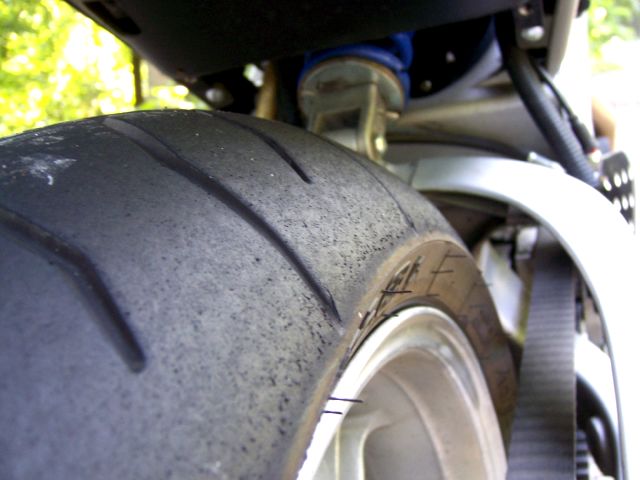 Were this tire a radial, we would see a capital letter “R” separating the aspect ratio and rim size. Since that is not the case here, you can be certain this is a bias-ply tire. Were this tire a bias-belted tire (like a bias-ply tire with additional, stiffening layers of fabric placed over the body plies), a capital letter “B” would separate the aspect ratio and rim size. It's easy to see this tire is made to be mounted on a 16-inch wheel.
Were this tire a radial, we would see a capital letter “R” separating the aspect ratio and rim size. Since that is not the case here, you can be certain this is a bias-ply tire. Were this tire a bias-belted tire (like a bias-ply tire with additional, stiffening layers of fabric placed over the body plies), a capital letter “B” would separate the aspect ratio and rim size. It's easy to see this tire is made to be mounted on a 16-inch wheel.
Other information shown are speed ratings and load ranges. Load ranges give the maximum weight a tire can carry, and speed ratings list the maximum speed at which the maximum load can be carried. Charts to find a given load or speed for a particular letter or number again are available in a multitude of places, so we’re not including them here. If you cannot find one, just ask us for help!
There’s one more tire “code,” called the service description, and we’ll talk about it quickly in a little bit. It’s not universal to the information given on a sidewall, so we’re not covering it here.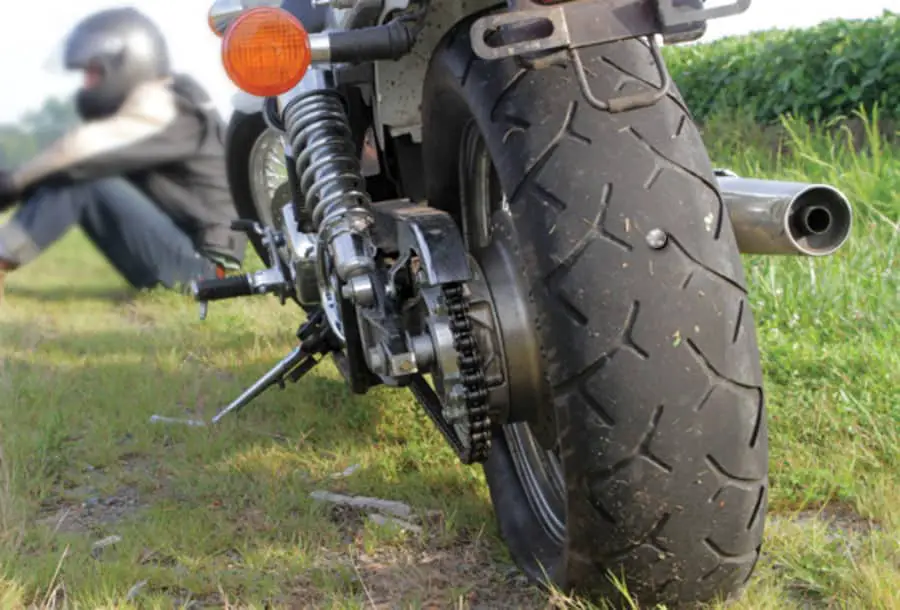
As long as you stick to the stock size tire that your motorcycle was designed to use, you're good to go. That doesn't mean you can't experiment. Depending on your motorcycle, you may still have a choice of sport tires, designed to provide maximum grip at the expense of tread life, touring tires designed for maximum mileage, or sport-touring tires that strive to provide the best of both. For adventure bikes, you can choose between tires that are intended as 90-10 (90 percent street use, 10 percent off road) or 50-50 or some other combination.
Of course people love to experiment, and sometimes that means departing from stock tire types and sizes. Our customers have brought us some humdingers of questions, so we’re going to try to cover the ones we get most often.
The most important thing to remember when selecting a tire is something each of our Gear Geeks absorbs to the core, and we encourage our customers to take the same stance: We always will err on the side of safety. Many customers will ask, “Can I…” followed by some deviation from standard practice. Some ideas kicked off by lone amateurs have been fantastic, while others have caused injury or death. We at RevZilla respect the rights of each motorcyclist to choose what modifications to make, but because we are unable to quickly evaluate every customer’s abilities and judgment through simple phone and e-mail contacts, it is RevZilla’s stance to only recommend tires that are original size, speed rating, load rating, and construction as the original equipment manufacturer’s.
Many customers will ask, “Can I…” followed by some deviation from standard practice. Some ideas kicked off by lone amateurs have been fantastic, while others have caused injury or death. We at RevZilla respect the rights of each motorcyclist to choose what modifications to make, but because we are unable to quickly evaluate every customer’s abilities and judgment through simple phone and e-mail contacts, it is RevZilla’s stance to only recommend tires that are original size, speed rating, load rating, and construction as the original equipment manufacturer’s.
Without further ado, here’s the FAQ!
Boy, if only it was that easy! There’s a reason that there’s not a common list of stuff that will fit on a given bike. Most people don’t sit around the shop with a stack of tires trying to fit different ones onto their wheels. A lot of things need to be taken into account when changing a tire size.
Tires need clearance in many dimensions.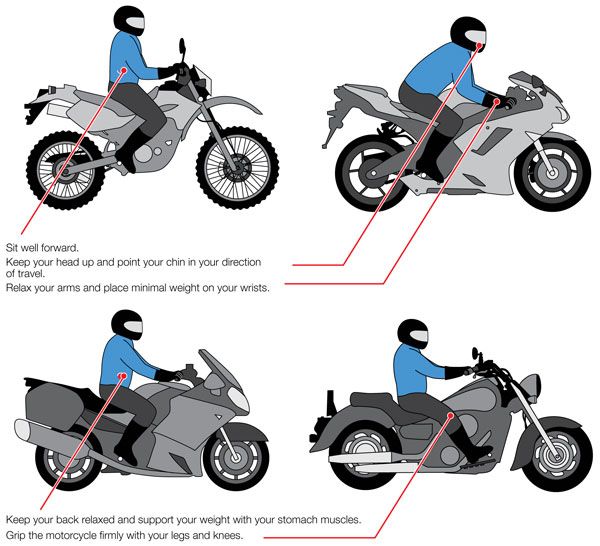 A tire that is too wide can rub a swingarm, chain, or other parts. A tire that is too large in circumference will change gearing ratios and speedometer readouts, and can contact fenders or swingarms. If clearance is tight when you mount the tire, keep in mind it can still cause problems. Tires “grow” at speed. Temperature and centrifugal force cause a spinning tire to be measurably larger than one at rest.
A tire that is too wide can rub a swingarm, chain, or other parts. A tire that is too large in circumference will change gearing ratios and speedometer readouts, and can contact fenders or swingarms. If clearance is tight when you mount the tire, keep in mind it can still cause problems. Tires “grow” at speed. Temperature and centrifugal force cause a spinning tire to be measurably larger than one at rest.
Wide tires are not necessarily better. They usually “turn in” worse than a skinnier tire of the same make and model, and usually hurt fuel mileage. The common alteration of mounting a wider rear tire may make the bike harder to steer, even unpleasantly or unsafely so.
While wider tires rarely provide performance advantages, some tire manufacturers do offer their own “plus sizing” recommendations, by listing tire sizes larger than stock that are confirmed to fit a certain size rim.
Again, we respect a customer’s right to choose, but we only recommend sticking with a manufacturer’s recommended tire construction type.
In general, radial tires offer lower temperatures (leading to longer life), stiffer construction, and the ability to have sidewalls with a lower aspect ratio, resulting in less flex. Bias-ply tires offer a softer, more compliant ride and, typically, a little lower price. Their other main advantage is load-carrying capability. In a given size, you’ll typically see a bias handle more weight. It explains why Harley (a big player in the heavy cruiser market) and certain touring bikes use them.
Interestingly, for some manufacturers, a mix of a bias front and radial rear is the setup from the factory.
Great question. For you rookies out there: Spoked rims will leak air if the tires mounted to them do not have an inner tube installed in them to hold the air. The nipples where the spokes mate to the rim are not airtight. A notable exception to this rule is the edge-spoked rims commonly found on a few bikes, such as BMW GS-series adventure-tourers.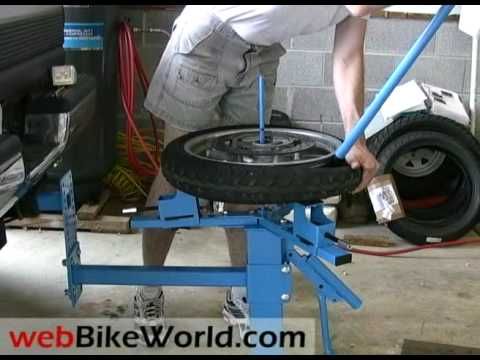 Even some alloy rims require tube-type tires, especially older bikes.
Even some alloy rims require tube-type tires, especially older bikes.
Bottom line: If your bike came with tube-type tires with inner tubes, you're not going to be able to use a tubeless tire without some creative engineering to make the rim airtight. And even then, there's no guarantees, because the beads may not seat properly on a wheel made for tube-type tires. So this is one of those things we just can't recommend.
This is generally fine to do. Note that the addition of a tube adds friction — and thus heat — into a tire. Most sources agree that if adding a tube, it's prudent to assume the tire has "stepped" down one load and speed step.
Not a great idea. In tubeless tires, the valve stem is generally replaced at every tire swap. With an inner tube, the valve is built right into the tube itself. Rubber hardens as it heat-cycles — the process of going from cold to hot and back to cold again, every time you ride — and the tube's rubber, which should be soft and pliable, turns brittle and can be prone to cracking.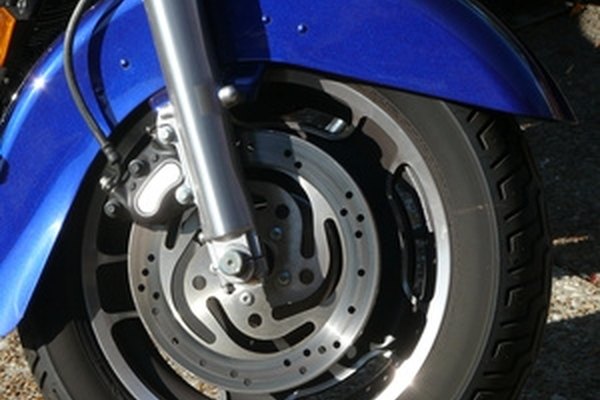 Compared to tires, tubes are cheap. Bottom line: Don’t do it. Replace the tubes with the tires.
Compared to tires, tubes are cheap. Bottom line: Don’t do it. Replace the tubes with the tires.
That's easy. Here's a conversion chart!
There are two types: 8 mm and 10 mm. The larger one, which actually fits an 11.3 mm hole in the wheel, is by far the most common size. It's used by all the Japanese manufacturers and Harley-Davidson. The smaller size, actually an 8.3 mm opening, is used by some BMWs and Buells and aftermarket wheels.
Normally, a downgrade in load/speed rating is a poor idea and we don’t recommend it at RevZilla. Maximum load and speed ratings are considered by the manufacturer and they specify tires they believe the bike needs.
Upgrading a speed or load rating won’t hurt anything, but can give a worse ride due to sidewall stiffeners being added to the tire.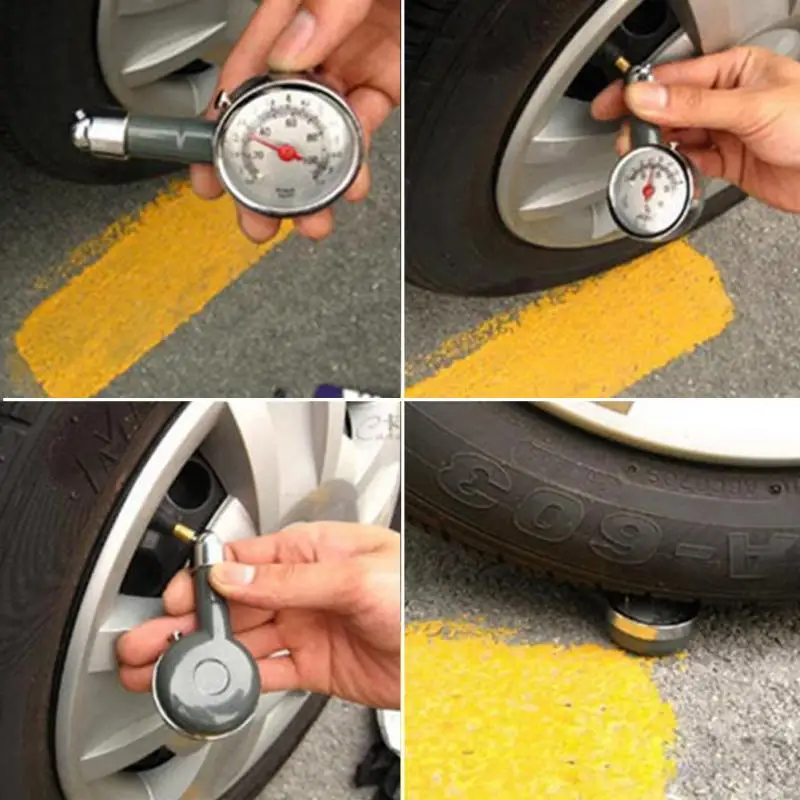 Factory-spec tires should be capable of handling the load the bike is approved to carry. If you're trying to exceed that, most likely the tires are not the only weak point and other parts can break, too! A higher speed rating is rarely detrimental, though you may give up fuel mileage or tire life. We recommend sticking to the OE speed rating, but upgrading is permissible, provided you know that other riding characteristics could be affected.
Factory-spec tires should be capable of handling the load the bike is approved to carry. If you're trying to exceed that, most likely the tires are not the only weak point and other parts can break, too! A higher speed rating is rarely detrimental, though you may give up fuel mileage or tire life. We recommend sticking to the OE speed rating, but upgrading is permissible, provided you know that other riding characteristics could be affected.
When considering weights, do not forget the weight of rider, passenger, luggage, etc. Japanese bike manufacturers are notorious for expecting their customers to be featherweights.
At the time of this writing, most tire manufacturers agree that a tire that has been repaired loses any speed rating.
If you see a letter and number combo listed after a tire size, that is a tire “service description.” Service descriptions all have a load and speed index, which are easily converted from a number of commonly available tables.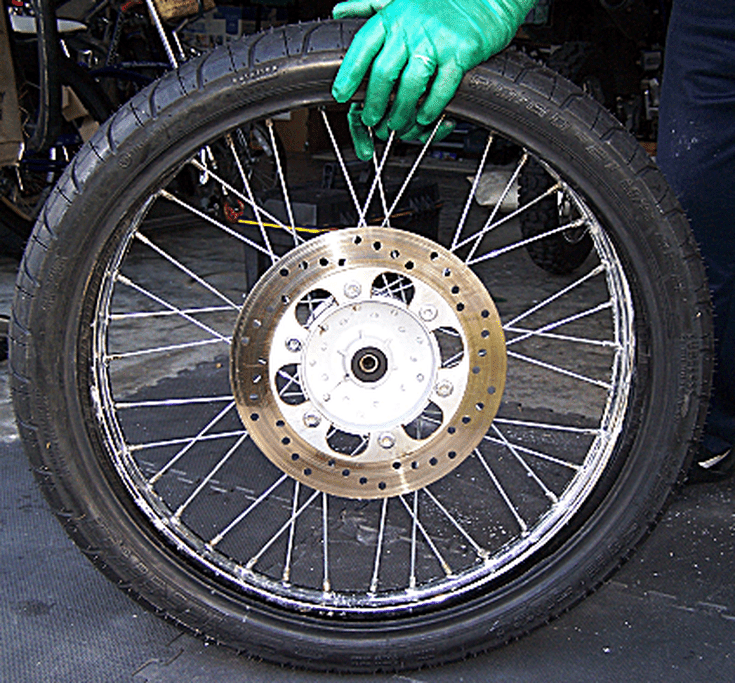
There is also additional, optional information you mayu see which can vary from manufacturer to manufacturer. It’s sometimes information that the tire producer gives to further clarify what the tire belongs on, or what job the tire was designed to do. It may indicate a slightly different version of a tire that is made specifically for a certain new model of bike, at the motorcycle manufacturer's request. Michelin Pilot Road 3 Tires are a good example of this. The “B” service description denotes a tire with extra sidewall stiffeners added. If you are unsure what a service description means, consult your friendly Gear Geek for clarification.
There are rare instances where the OEM tires are mixed brands, but other than those exceptions, RevZilla recommends replacing tires with the tire manufacturer’s recommended match front or rear. Often, a manufacturer will recommend a different model of tire for front and rear, and we will follow that recommendation.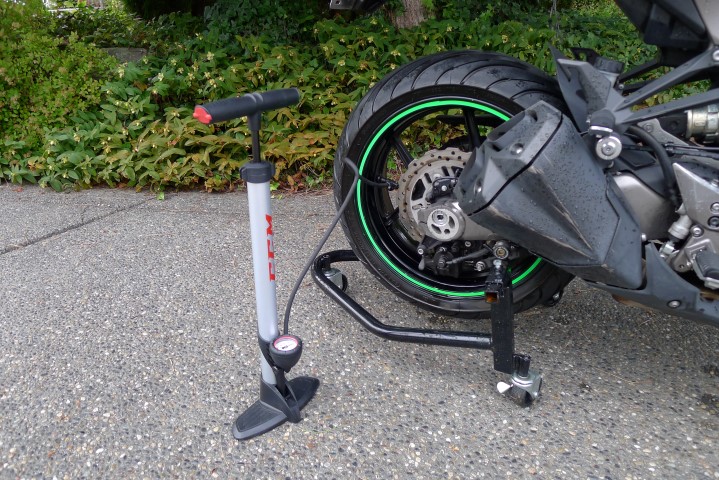 Unless a bike was equipped with two different tires from the factory, we do not recommend mixing tire brands because differences in tire handling and performance can cause an otherwise well-behaved motorcycle to act in an unpredictable, unsafe manner. Tire manufacturers engineered their tires to work with a matched partner. You paid for all that engineering, so why not use it?
Unless a bike was equipped with two different tires from the factory, we do not recommend mixing tire brands because differences in tire handling and performance can cause an otherwise well-behaved motorcycle to act in an unpredictable, unsafe manner. Tire manufacturers engineered their tires to work with a matched partner. You paid for all that engineering, so why not use it?
Yup! Tire age does matter!
Fortunately, it's easy to tell your tire's age. Molded into the sidewall of every tire is a DOT code, typically 12-16 digits or so. The code starts with the letters “DOT” and ends with a mishmash of numbers which tell many things, including the date of manufacture and plant it was produced in. We are interested in the last block of numbers. If there is a three-digit number in the final block of numbers, the tire was produced prior to 2000 and probably needs to be replaced! A four-digit number will reference the week of production in the first two digits, and the year in the last two.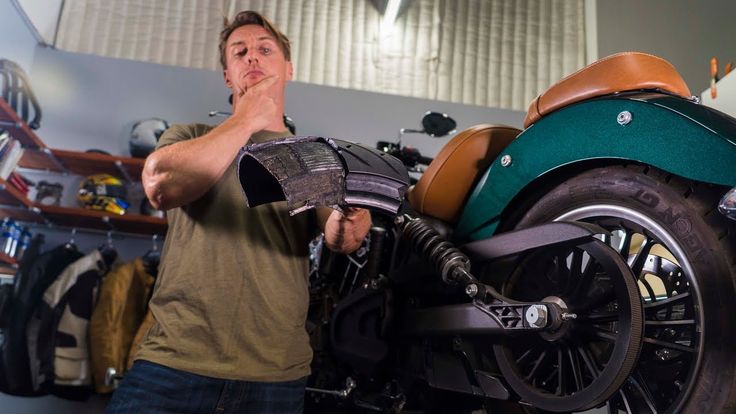 For example, 4209 as the final four characters in the DOT code indicates that the tire was made in the 42nd week of 2009.
For example, 4209 as the final four characters in the DOT code indicates that the tire was made in the 42nd week of 2009.
If the tires on your bike are five years old, RevZilla recommends an inspection by a trained tire professional. If they're 10 years old, you should probably replace them regardless of how they look.
We do not guarantee motorcycle tires ordered from RevZilla will be of a certain age. However, be assured that our stock rolls over really frequently, and you will be getting a tire of very recent production.
Because it’s flat? That would be a good replacement situation…
Let’s run down a quick list of times when motorcycle tires should be replaced:
If you’re asking us this question, you probably need at least one new tire, and likely two.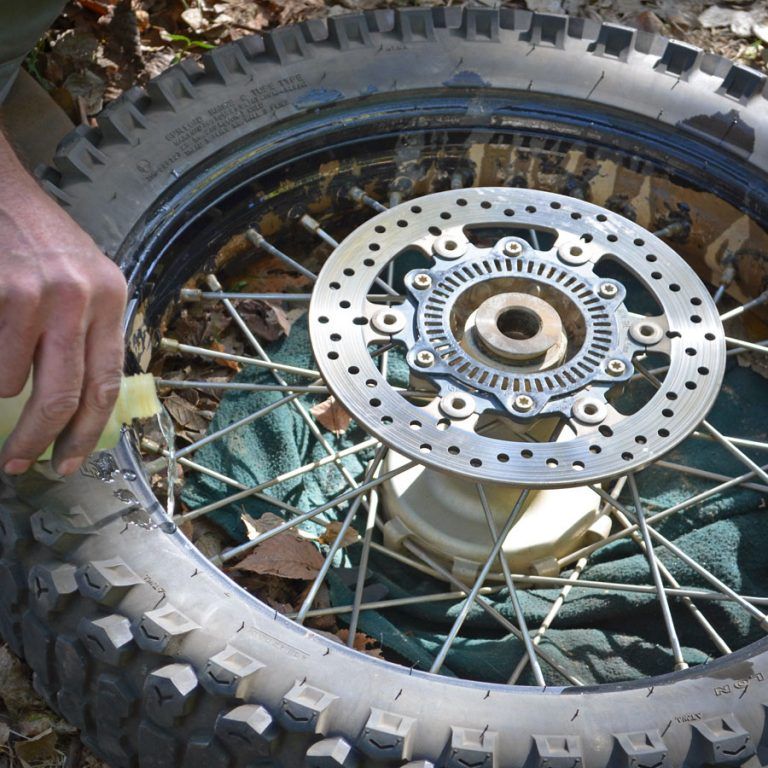 Given that most bikes have a tire speed rating, and repaired tires lose their speed rating, many riders with any type of tire damage really need a new tire. The safest course is to consider a repair a temporary fix at best. Given how critical tires are to your safety and your motorcycle's performance, RevZilla urges customers to stay safe.
Given that most bikes have a tire speed rating, and repaired tires lose their speed rating, many riders with any type of tire damage really need a new tire. The safest course is to consider a repair a temporary fix at best. Given how critical tires are to your safety and your motorcycle's performance, RevZilla urges customers to stay safe.
Well, you could have a defective tire. Or maybe a defective install. It’s hard to say without having the situation assessed by a trained professional. As a former tire installer, I would say that perhaps two percent of all tire problems were caused by truly defective tires. Chatter from a tire typically comes from normal wear and cupping, and sometimes from incorrect inflation, or a combination of those things. Wobble is almost always caused by misaligned tires, bent axles, or, most commonly, worn bearings. Tread and wear issues are usually caused from wheels having crooked installation or improper inflation.
It’s hard to say what you may be facing without seeing the problem firsthand. If you want some suggestions from a Gear Geek on what could be going on with your particular tire, information about the bike, tire installation, circumstances surrounding the failure, and pictures are all really, really helpful. It’s the best first step in determining if you’ve got a problem, and what should be done to remedy it. We maintain great relationships with our tire manufacturers, so we often tap their experience and that can be a huge resource when we are trying to help you!
Because the street’s not the track! Track tires often have compounds requiring very hot temperatures to “stick” to the road that a rider — even an aggressive one — will not hit on the street. This means that in real use, the track-day tire may be less grippy on the street than a sporty street tire.
Track-day tires also have different cross sections, usually inviting quicker steering, but twitchier handling.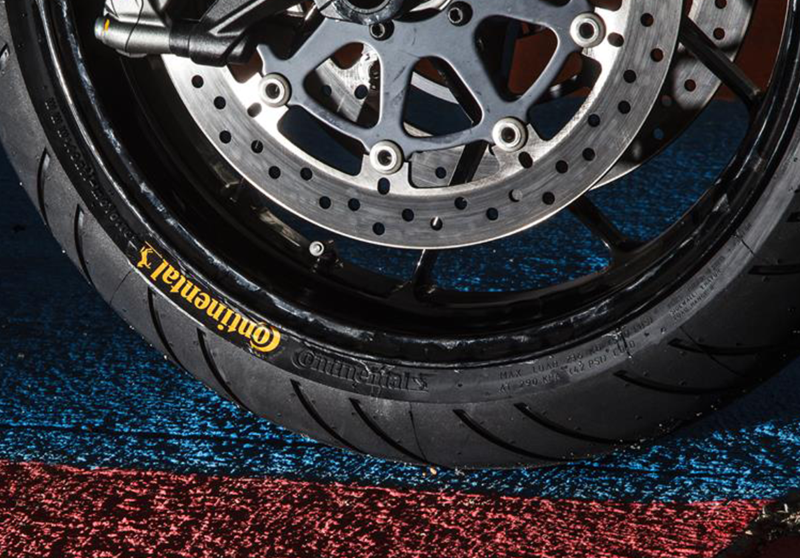 They are almost never optimized for wear and they probably don't handle water or debris well, since those are usually absent on the track, though that cannot be said of city streets. Track tires also rarely take into account loaded riding that street bikes are frequently saddled with. There are a number of super-sticky street tires that really bridge the gap between track and street use and they are almost universally the best choice for the rider who asks this question.
They are almost never optimized for wear and they probably don't handle water or debris well, since those are usually absent on the track, though that cannot be said of city streets. Track tires also rarely take into account loaded riding that street bikes are frequently saddled with. There are a number of super-sticky street tires that really bridge the gap between track and street use and they are almost universally the best choice for the rider who asks this question.
Have a question that's not answered here? Drop us a line or give us a call. We never “tire” of talking to our customers!
***Whether from smoking your meat with hooligan antics or just logging a ton of miles, eventually you are going to need new tires. Let this guide answer some of the basic how, why, what and when of tire replacement.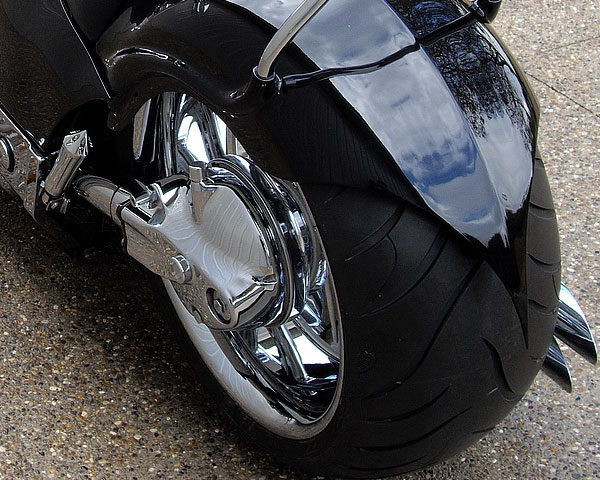 ***
***
Buying new motorcycle tires ain't what it used to be. In fact, it can be downright intimidating if you're not up to date with the current vernacular that surrounds motorcycle tires: V or Z ratings, 180s, 240s, radial or bias ply, load indexes, speed ratings - see what I mean? It's easy to get overwhelmed by the wealth of information that's out there. So Motorcycle USA wants to ease the pain of the process by offering a basic guide for knowing when it's time to break open the wallet and come up with a few dollars to throw down for some new treads.
Motorcycle tires are often ignored and underappreciated, which isn't the smartest of decisions since they are the intermediary between you and a face-full of asphalt. Even more than with automobiles, running on the proper motorcycle tires are paramount to safe transportation. The right tire can also mean the difference between being crowned MotoGP World Champion or settling for runner-up - just ask Valentino Rossi. Even if you're not looking to drag a knee at Sepang, it's just as imperative for the layman rider to keep their tires in the best possible working condition.
Bridgestone, Michelin, Metzler, Dunlop and more... There's a lot of tire ground to cover. So here it is. We're by no means claiming to be the authority on tire selection and maintenance, but we wanted to provide readers with some general guides and answers to some of the FAQs when it comes time to slap on a set of new rubbers.
***Unlike factory racers who get a fresh set of rubber after each outing, us normal Joes will need to use some observation and common sense to determine when is the right time to swap tires.***
It doesn't take a genius to know you need new motorcycle tires. When your back end starts to feel a little loose in corners that you've blasted through a hundred times before, it's time to check your tread depth. Use the built-in tread wear indicators. When the tire is worn down to the indicators that are set at 1/32nd inch (0.8 millimeters) or when the tread groove depth is even less, it's time to change. Thin tires are penetrated by nails and shrapnel much easier than ones with healthy tread. A good way to gauge this is with a penny. Take a penny and stick it upside down in the tread groove. The space between the edge of the penny and the top of Lincoln's head is about 1/32nd of an inch. If Lincoln needs a haircut, you need a new tire. If the tire cord or fabric is exposed, the tire is dangerously worn and must be replaced immediately.
Thin tires are penetrated by nails and shrapnel much easier than ones with healthy tread. A good way to gauge this is with a penny. Take a penny and stick it upside down in the tread groove. The space between the edge of the penny and the top of Lincoln's head is about 1/32nd of an inch. If Lincoln needs a haircut, you need a new tire. If the tire cord or fabric is exposed, the tire is dangerously worn and must be replaced immediately.
It's also a good idea to inspect the conditions of your wheels periodically. Bent rims may cause wheel wobble, bead unseating and, in the case of tubeless tires, gradual air loss. Sudden wheel failure may result from the use of cracked cast wheels. Bent rims and bent or cracked cast wheels should be replaced immediately.
Finally, inspect your tires for uneven wear. Wear on one side of the tread or flat spots in the tread may indicate a problem with the tire or motorcycle. Always heed warning signs such as vibration, handling instability, rubbing or tire noise that occurs during operation of the motorcycle.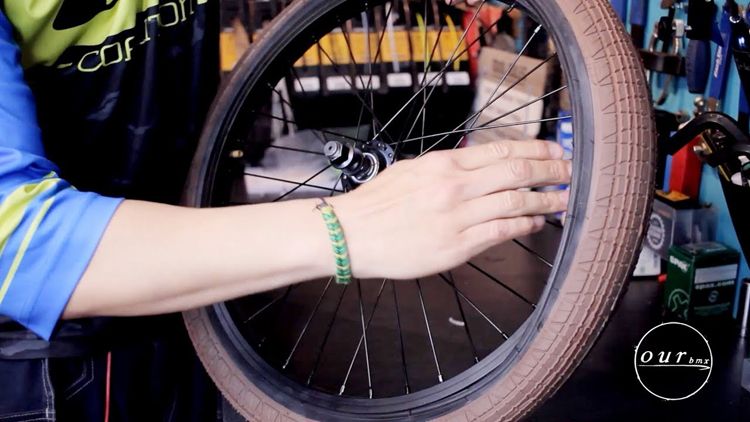 If this is the case, it's best to contact your local dealer.
If this is the case, it's best to contact your local dealer.
***Going too long without new knobbies will ultimately result in something like this. Determining lifespan for off-road tires is more subjective, but using the wear indicators will help prevent this from becoming a common occurance.***
Off-Road - One of the main differences between street and dirt bike tires is in determining wear factor - you definitely don't want to get your knobbies down to 1/32-inch! The most critical deciding factor is personal feel. Technically you can run those knobbies down to pathetic little nubbins, but the further they are worn, the more susceptible they are to puncture and fatigue failure, not to mention a lack of traction and safety. Once you can feel the performance of your tire slipping - literally - then it's time to start looking for a replacement. Keep in mind that some rounding of the front edge can actually increase performance on harder terrain, so don't go tossing a perfectly good tire if it isn't biting right away.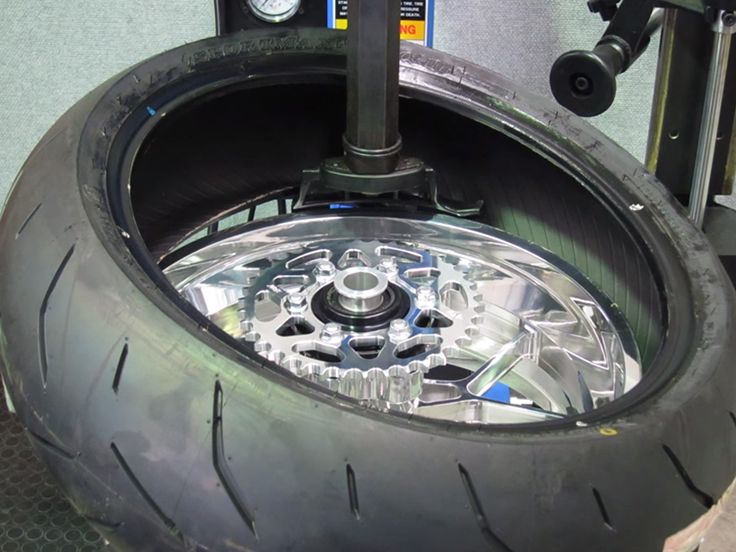 Most meats, however, are going to only get worse with age and use. Some tires chunk or tear worse than others, but watch the wear grooves in the center lugs to indicate how abused the rubber is. If there aren't any grooves left it's time to move on.
Motorcycle Tire Inflation
Most meats, however, are going to only get worse with age and use. Some tires chunk or tear worse than others, but watch the wear grooves in the center lugs to indicate how abused the rubber is. If there aren't any grooves left it's time to move on.
Motorcycle Tire Inflation
CHECKING TIRE PRESSURES IS THE MOST IMPORTANT TIRE MAINTENANCE FUNCTION YOU CAN PERFORM.
Why the capital letters? Because we can't stress this enough. Check your tires' air pressure at least once a week and before long trips. Be sure to use an accurate pressure gauge. Common sense, you say? You'd be surprised.
***Incorrect inflation can lead to uneven wear, so use your contact patches as an idicator. And remember, having too much pressure can be just as dangerous as too little.***
Check air pressure when the tires are cold. Tires are cold when a motorcycle has been ridden less than a mile at moderate speed or after it has been sitting for three or more hours. Never release air from a hot tire in order to reach the recommended cold tire pressure. Normal riding causes tires to run hotter and inflation pressure to increase. If you release air when your tires are hot, you may under-inflate your tires to dangerous levels.
Normal riding causes tires to run hotter and inflation pressure to increase. If you release air when your tires are hot, you may under-inflate your tires to dangerous levels.
If for some reason your tires are losing more than two psi per month, the tire, valve, or wheel may be damaged. Have your local dealer check it out. Always keep the air pressure in both tires at the manufacturer's recommended psi. Your motorcycle owner's manual will tell you this magic number. On some motorcycles, the recommended front and rear tire pressures differ, and the numbers stamped on the sidewall of the tire are often only for maximum loads. Occasionally, these pressure numbers are the manufacturer's recommended settings as well, but always check your owner's manual first. Having the proper tire pressure improves handling, gas mileage and keeps you safer in the saddle.
Riding on underinflated motorcycle tires is dangerous for several reasons. The tires will build excessive heat and can cause sudden tire failure.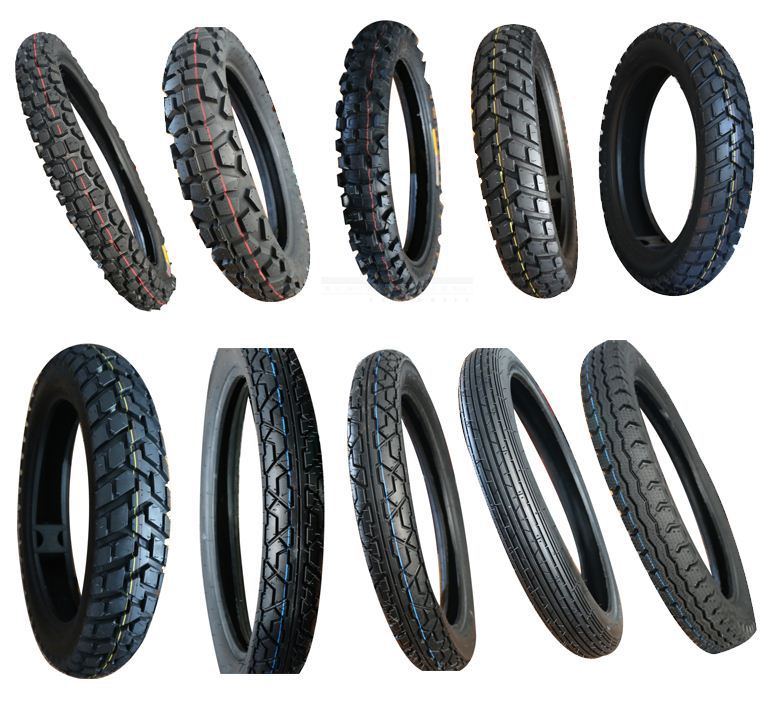 Under inflation causes irregular tread wear at the edge of the contact patch and may also damage the tire beyond use. It will affect cornering, cause you to lose precious gas mileage, and can cause fatigue cracking.
Under inflation causes irregular tread wear at the edge of the contact patch and may also damage the tire beyond use. It will affect cornering, cause you to lose precious gas mileage, and can cause fatigue cracking.
Riding on tires with too much air is equally as dangerous. The tires are more likely to be cut, punctured, or broken by sudden impact. Overinflating will cause the bike to ride hard and will cause the tire to wear out quickly in the center of the contact patch. Do not exceed the pressure indicated on the tire sidewall. Consult your owner's manual for the recommended psi and for other useful tidbits of info on your tires.
Never inflate a tire unless it is secured to the motorcycle or a tire-mounting machine. Inflating an unsecured tire is dangerous because if it bursts, it could be hurled into the air with lethal force.
***All you custom guys and gals need to think twice about those chrome valve caps. Little things like that can eventually lead to a loss of air pressure.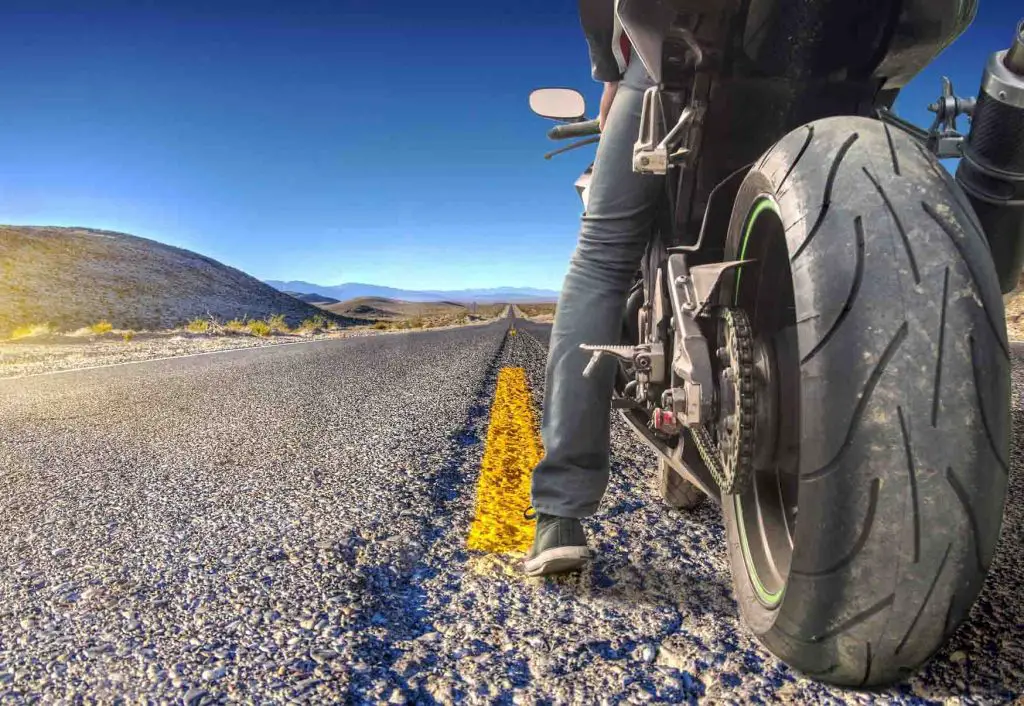 Be sure to monitor psi like your life depends on it - because it does.***
Be sure to monitor psi like your life depends on it - because it does.***
Another helpful hint is to use factory valve caps and to keep valve cores clean and clear of debris to help guard against air leakage. And while the chrome skull-shaped valve caps look cool, it's better to keep the original caps on your valve stems because the manufacturer's valves have a rubber gasket in the top and will seal better. Valve caps not only keep debris and water out of your valve stem, they keep the air in. Wheel rotation can be enough to cause a valve core to open due to the centrifugal force generated.
Motorcycle tires with non-repairable damage must not be used again. This type of damage can be incurred by hard impacts, penetrations or by continued use of an underinflated/overloaded tire. Such types of damage are progressive and can cause sudden and complete tire failure and result in an accident.
Off-Road - Most of this holds true for off-road as well, but because of the dirt world's changing terrain, tires can serve as more of a ride-tailoring factor.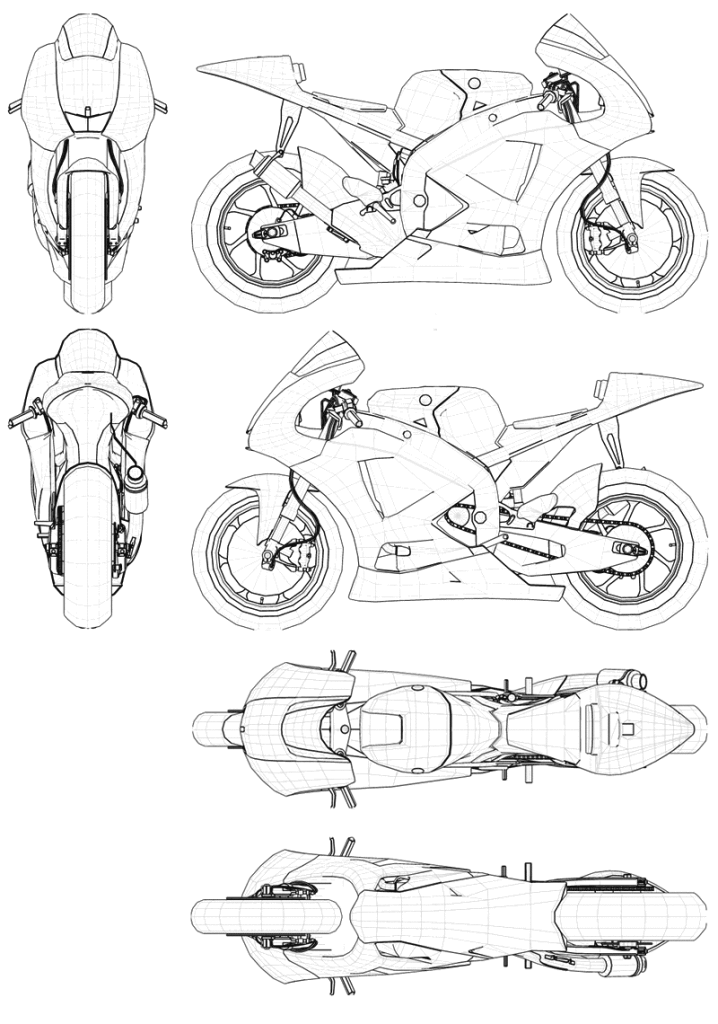 Different rubber compounds and tread patterns are critical to finding the ultimate traction whether you ride in sand, mud, loam, blue-groove or any combination. Most bikes come from the dealership with an intermediate tread of some kind, which should work well enough to get you started. Once that tire is shredded, keep in mind how it performed and what your normal riding terrain is like before purchasing your next meat. Bike and tire manufacturers provide recommended psi figures, but in the dirt world they aren't necessarily the end all be all.
Different rubber compounds and tread patterns are critical to finding the ultimate traction whether you ride in sand, mud, loam, blue-groove or any combination. Most bikes come from the dealership with an intermediate tread of some kind, which should work well enough to get you started. Once that tire is shredded, keep in mind how it performed and what your normal riding terrain is like before purchasing your next meat. Bike and tire manufacturers provide recommended psi figures, but in the dirt world they aren't necessarily the end all be all.
***Changing terrain will play a huge factor in dictating air pressure for off-road tires. What works in one area may be completely wrong for your next ride, so adjust accordingly.***
Proper inflation depends entirely on where you are riding. High speed, rocky terrain requires higher psi to avoid pinching tubes and tacoed rims. However, leaving 18 pounds in after a weekend desert ride and then hitting the muddy forest trails for a mid-week outing will probably result in a soil sample. As a general rule of thumb, 11-15 pounds will get you through most terrain in suitable fashion, but don't be afraid to experiment with the pressure a bit as you get more comfortable with your tires. Just make sure to make slow and steady adjustments. Elevation can also have an affect on inflation so it never hurts to pack a pump before you head out to the mountains. Always be sure to check your pressure and adjust it accordingly.
As a general rule of thumb, 11-15 pounds will get you through most terrain in suitable fashion, but don't be afraid to experiment with the pressure a bit as you get more comfortable with your tires. Just make sure to make slow and steady adjustments. Elevation can also have an affect on inflation so it never hurts to pack a pump before you head out to the mountains. Always be sure to check your pressure and adjust it accordingly.
Another thing to keep in mind with off-road tires is the rim lock, also called a bead lock. Since flats are more common off-road, these little babies can mean the difference between getting back to the truck or a long, miserable night. We like to run our rim locks pretty stinkin' tight. Small punctures can sometimes be fixed on the trail with patch kits or slime (though this should only be used as a temporary fix to get you home), but if the tire spins too violently on the rim it will tear the stem out of the tube, and then there's no hope for a simple repair.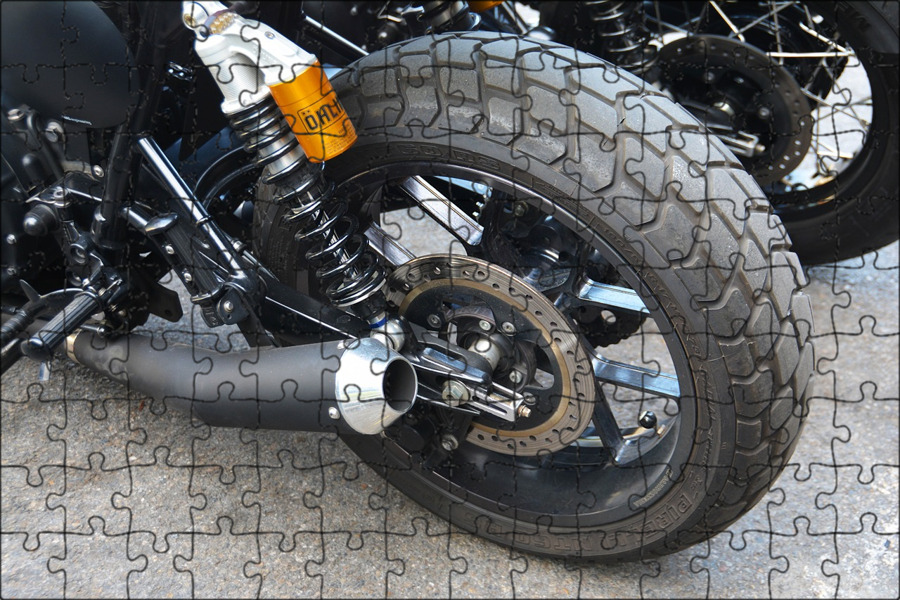 Make sure not to cinch the nut down so tight that it damages the rim, but we like to give ours an extra little twist just to make sure it's going to hold.
Make sure not to cinch the nut down so tight that it damages the rim, but we like to give ours an extra little twist just to make sure it's going to hold.
***Wheel alignment and balance is key to a smooth, safe ride. Wheels that are out of spec also cause excessive tire wear.****
You might think it's not as important to have motorcycle tires balanced and aligned, but it is. Have your tire/wheel assemblies balanced before using them and rebalanced each time the tire is removed or replaced. Unbalanced tire/wheel assemblies can vibrate at certain speeds, greatly accelerating tire wear. If you take off your rear wheel or adjust the chain or belt, have your tire balanced. Each revolution of an incorrectly aligned wheel can scuff off tread rubber, reduce tire mileage, and impair steering and cornering.
Correct matching of front and rear tires is important for peak performance and handling. Mating a new tire with a worn tire is never a good idea.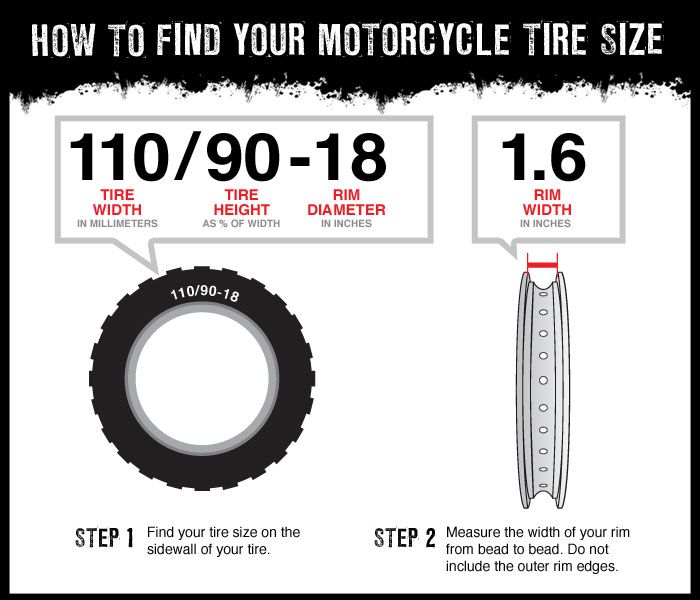 It is best to follow the Tire Selection guidelines provided by the manufacturers and change out both tires at the same time if possible. A new front tire with a worn rear tire can cause instability.
Also, make sure that the tires are mounted in accordance with the directional arrows. There are two main reasons for directional arrows. The first of these is that some motorcycle tires now have tread patterns that are designed for a specific rotation for optimum performance, particularly on wet roads. Directional arrows indicate the proper directional rotation.
Secondly, running a tire will set up a wear pattern and it might not roll smoothly if reversed. Use the directional arrow to re-fit a tire in its original direction.
It is best to follow the Tire Selection guidelines provided by the manufacturers and change out both tires at the same time if possible. A new front tire with a worn rear tire can cause instability.
Also, make sure that the tires are mounted in accordance with the directional arrows. There are two main reasons for directional arrows. The first of these is that some motorcycle tires now have tread patterns that are designed for a specific rotation for optimum performance, particularly on wet roads. Directional arrows indicate the proper directional rotation.
Secondly, running a tire will set up a wear pattern and it might not roll smoothly if reversed. Use the directional arrow to re-fit a tire in its original direction.
Off-Road - It isn't as important in dirt to have matching tire sets. Plenty of riders even swap brands between front and rear based on their personal preferences. When it comes to wear, if you can afford a complete set at every change then go for it, but a front tire will generally last as long as two rears. Again, look at the wear markers and always err on the side of safety. Most off-road tires are not directional and can even be reversed to stretch additional life out of them. But, there are some, especially soft-terrain and dual-sport meats, that can have a specific rotational tread pattern. Always make sure to pay attention to any arrows or markers on the sidewall and obey them.
Again, look at the wear markers and always err on the side of safety. Most off-road tires are not directional and can even be reversed to stretch additional life out of them. But, there are some, especially soft-terrain and dual-sport meats, that can have a specific rotational tread pattern. Always make sure to pay attention to any arrows or markers on the sidewall and obey them.
***Tires have a lot of technology in their construction these days. Different compounds and tread patterns create the ultimate blend of performance and longevity. But, mixing radial and bias is a no-no in most circumstances.***
Bias and radial tires have significantly different dynamic properties. Bias, bias belted and radial tires have different construction types and therefore have different abilities to carry side and peripheral forces as well as having varied damping characteristics. The introduction of radial tires required changes to certain characteristics of the motorcycle.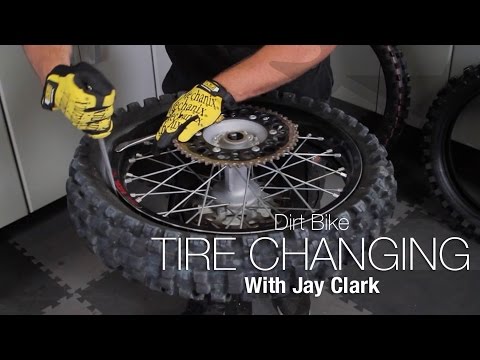 The development of the radial tire led to frame modifications, new steering geometries and suspensions. That's why it is recommended that a motorcycle be used with the type of tire construction that it came with originally. Do not mix bias ply and radial tires on the same motorcycle unless it has the approval of the motorcycle or tire manufacturer.
The development of the radial tire led to frame modifications, new steering geometries and suspensions. That's why it is recommended that a motorcycle be used with the type of tire construction that it came with originally. Do not mix bias ply and radial tires on the same motorcycle unless it has the approval of the motorcycle or tire manufacturer.
Tread pattern is the outer part of the tire and in contact with the road. The profile of a tire and the rubber compound chosen is based on the use of the tire. Generally, street motorcycle tires with a harder rubber compound get better gas mileage but don't stick to the road as well. The softer the rubber compound, the grippier a tire is, at the sacrifice of gas mileage.
Tread has everything to do with the circumstances you'll be driving in most. A treadless racing slick will stick to the road like glue but is useless in the rain. Tread is needed for traction in wet conditions. That's why off-road tires have a very high tread.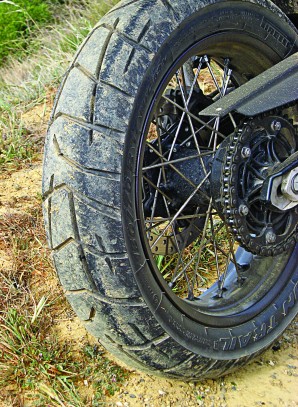 It enables them to maintain traction in the mud and deal with the adverse geography of off-road riding.
It enables them to maintain traction in the mud and deal with the adverse geography of off-road riding.
Tread builds up heat within a tire and reduces its effectiveness. An all-round tire has a light tread with a medium-hard compound base. This arrangement allows it to travel many miles without breaking down fast and provides stability in varying conditions.
Off-Road - Depending on where you ride, there is ultimately a tire compound best suited to your needs. Ranging from soft compounds for hard terrain to hard compounds for digging up that spongy loam, the type of rubber you use will directly affect your off-road performance. There is a difference in tread pattern and lug depth as well. Obviously, each tire is a bit different from any other, but aside from the normal variations, there's a big change in recent years due to the development of modern 4-strokes. Different power delivery and handling characteristics have led tire manufacturers to build specific 4-stroke treads. These meats typically have a wider tread pattern and an increased amount of lugs, especially on the sides. It's not to say that these tires won't work for 2-strokes, or vice-versa, but the specialized designs are becoming more available as the tire industry catches up to the new technology.
These meats typically have a wider tread pattern and an increased amount of lugs, especially on the sides. It's not to say that these tires won't work for 2-strokes, or vice-versa, but the specialized designs are becoming more available as the tire industry catches up to the new technology.
***Tires that require tubes should have their bladders monitored as well. Even if the tube is functioning properly, t's always a good idea to replace the tube whenever the tire is swapped, just for good measure.***
When putting on a new tire that requires a tube, slap on a new tube at the same time. Old tubes become stretched, and if an old tube is fitted in a new tire, it can crease and eventually fail due to thinning of the tube rubber. Tubes should be repaired only by an expert.
Always match the size markings on tubes to the tire. Don't fit tubes in radial motorcycle tires and don't fit radials on rims requiring tubes unless the tubes bear matching size and radial (R) markings.
Tires come with different load-carrying capacities. Read your owner's manual. It will list accessory restrictions and a motorcycle's load capacity. The maximum load figures are also molded on the tire sidewall. Before a trip, determine the total weight of luggage, equipment, and rider(s) to be added to the motorcycle. Be careful not to under-inflate tires which will reduce the bike's load-carrying capability.
Trailers can also cause extreme tire stresses and overloads that can cause irreversible damage and result in sudden tire failure and accidents. Most tire manufacturers do not recommend the use of trailers and will not warrant tires used on bikes fitted with trailers.
***Always be mindful of how much weight is on your machine. Tires are rated for certain load capacities and exceeding those recommendations is never a wise move.***
This Load Index Table will tell you how many pounds a tire can handle depending on its index rating.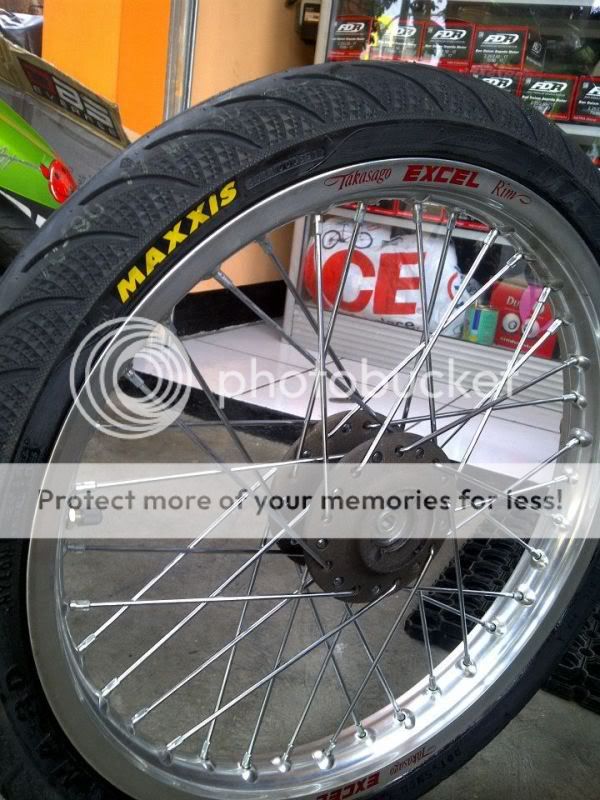 This load rating is often stamped on the side of the tire or you can consult your trusty owner's manual.
This load rating is often stamped on the side of the tire or you can consult your trusty owner's manual.
Give yourself a little time to get used to the way your new tires perform. When worn tires are replaced with differently patterned or constructed tires, they are not going to ride the same. When new tires are fitted, give them a break-in distance of at least 100 miles. That means avoid revving the engine up to maximum power, don't tilt too far leaning into a turn or blast into corners. This gives riders time to get the feel of the new tires, to find the edge, and will give them ample opportunity to find the best road grip for a range of speeds, acceleration and handling use. After your first big ride, check and adjust the tire's inflation to recommended levels after it has cooled for at least three hours.
Off-Road - A new dirt tire can be toast in 100 miles. The break in period for off-road is as quick as your learning curve can handle. You still need to be careful at first and get used to some of the grip qualities and handling characteristics so that you don't overestimate the available traction.
You still need to be careful at first and get used to some of the grip qualities and handling characteristics so that you don't overestimate the available traction.
These are not your tires' friends:
Sunlight - Tires stored in direct sunlight for long periods of time will harden and age more quickly than those kept in a dark or dimly lit area.
***Washing your bike's tires can be both good and bad. Make sure to scrub off any harsh chemicals like oil or gasoline, but stay away from Armor All. Soap and water will be fine.***
Oil and Gasoline - Prolonged contact with oil or gasoline causes contamination of the rubber compound. Wipe off any oil or gasoline immediately with a clean rag. This warning applies to corrosives or non-rubber compatible liquids as well. Avoid cleaners or dressings like Armor All. These may degrade the rubber and remove ozone cracking and weather-checking resistance.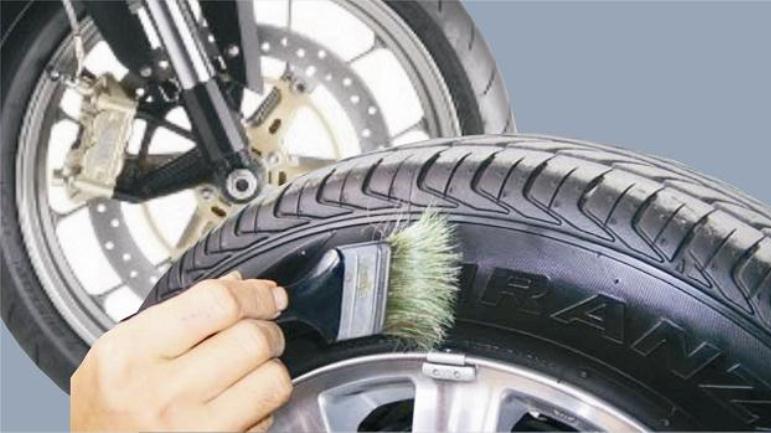 If you've got raised tires with sidewalls, white stripes or raised white lettering, which are common on cruiser motorcycle tires, use a mild soap solution to clean them up and then rinse with plain water.
Always seek expert inspection of the tire after plunking a curb, pothole or whenever you run over something hard. If a bulge appears, or if tire pressure decreases, don't ride on it. Take it in and have your local dealer check it out.
If you've got raised tires with sidewalls, white stripes or raised white lettering, which are common on cruiser motorcycle tires, use a mild soap solution to clean them up and then rinse with plain water.
Always seek expert inspection of the tire after plunking a curb, pothole or whenever you run over something hard. If a bulge appears, or if tire pressure decreases, don't ride on it. Take it in and have your local dealer check it out.
With all the numbers and letters on the side of a tire, it's easy to get confused, so here is the basic breakdown of what each one designates.
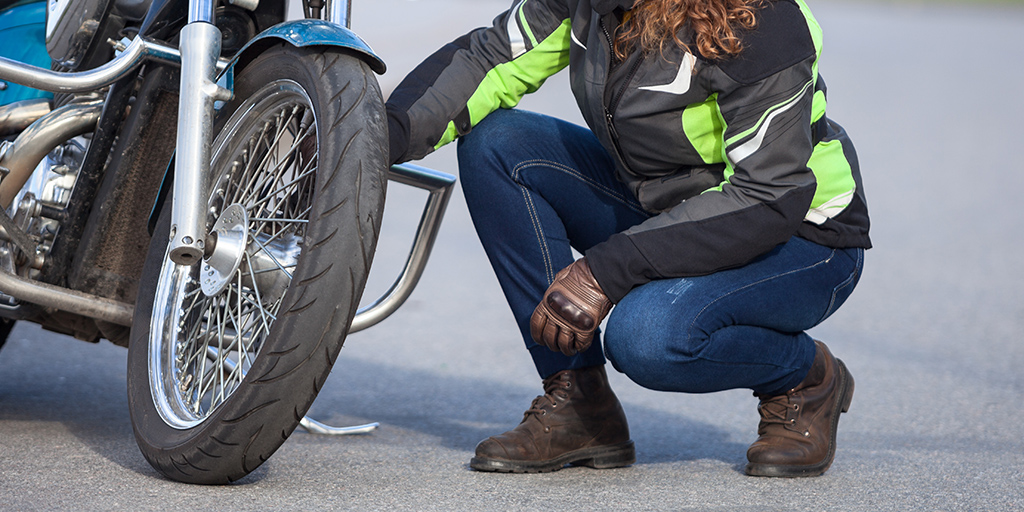 )
)***There's a ton of information on the sidewalls of your tires. Learning how to read the markings will make it easier to pick out the right tread for your machine.***
If you're going to be stuffing the saddlebags for a long trip or plan on taking your honey on a nice road trip, the added weight is going to change the handling characteristics of your bike. Luckily, the good people at the International Standards Organization (ISO) have researched how much pressure needs to be in a tire when a bike is carrying extra weight and provides riders with the results of their findings in the form of the ISO Load/Speed Index.
This code, when present, appears after the size marking. The code is made up of three characters-- two numbers and a letter. So, if your tire is stamped like this - 130/90 - 16 67 H - then the Load/Speed Index is the 67 H. The two-digit number is a code for the maximum load carrying capacity of the tire. The letter is a maximum speed rating and lets you know the highest speed at which the tire may be used safely with a full load when the maximum listed tire inflation pressure is used.
So, if your tire is stamped like this - 130/90 - 16 67 H - then the Load/Speed Index is the 67 H. The two-digit number is a code for the maximum load carrying capacity of the tire. The letter is a maximum speed rating and lets you know the highest speed at which the tire may be used safely with a full load when the maximum listed tire inflation pressure is used.
Sometimes tires won't have the Load/Speed Index listed at the end. They sometimes use the letters below stamped in between the width and the wheel diameter. The following table lists the speed ratings for each category of tire. The speed rating means that when a tire is pumped up to the maximum inflation pressure when carrying a load, the tire will perform safely up to a designated speed. The amount of pressure that needs to be in the tire, the maximum load that specific tire can handle and the highest speed you can travel at safely on that tire is stamped on the sidewall for you. You just need to know how to understand the code.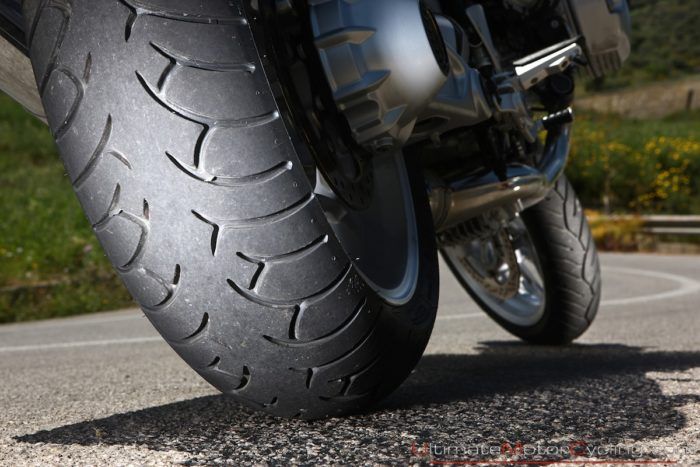 Click this link to see a list of speed ratings.
Click this link to see a list of speed ratings.
***Tires designed to exceed 149 mph have specific ratings. Check with your local dealer about availability and use of these specialty rubbers.***
A couple of quick notes... Certain "V" or "VR" rated tires may have a speed capacity greater then 149mph (240kph). Check with your local tire distributor for maximum speed information if your motorcycle exceeds this speed capability. Tires also come with a Z or ZR rating. These are high-performance tires built for speed. When they are pumped up to the max, the tire is will roll safely with the maximum marked sidewall load at sustained speeds in excess of 149mph and up to a speed determined by the tire manufacturer when installed on a specific motorcycle. Again, check with your local tire manufacturer to get these numbers.
And don't think that putting on a tire with a higher rating will upgrade your bike's performance. When a motorcycle manufacturer decides on the tires for a particular model, they make sure that the speed rating of the tire meets the maximum speed capability of the motorcycle. If you fit higher speed-rated tires, there is a good chance that you will sacrifice some other performance aspect such as mileage. This being the case, it is usually best to stay with the speed rating of the original tires.
If you fit higher speed-rated tires, there is a good chance that you will sacrifice some other performance aspect such as mileage. This being the case, it is usually best to stay with the speed rating of the original tires.
source: www.motorcycle-usa.com
contact us
Well, for starters, we ignore the advertising descriptions of a wonderful “hold” on any surface (“universality” of rubber is a myth, and a highway declared as such holds much worse than a special one in difficult conditions). The principle of “taking the most expensive and popular one” is also not suitable for choosing motorcycle tires: if you choose the wrong type or profile, the same advantages can turn into a serious problem, therefore, we carefully study the characteristics. And here it is important that you know about the types, tire design, features of the choice of operation (oddly enough) and the timing of changing tires.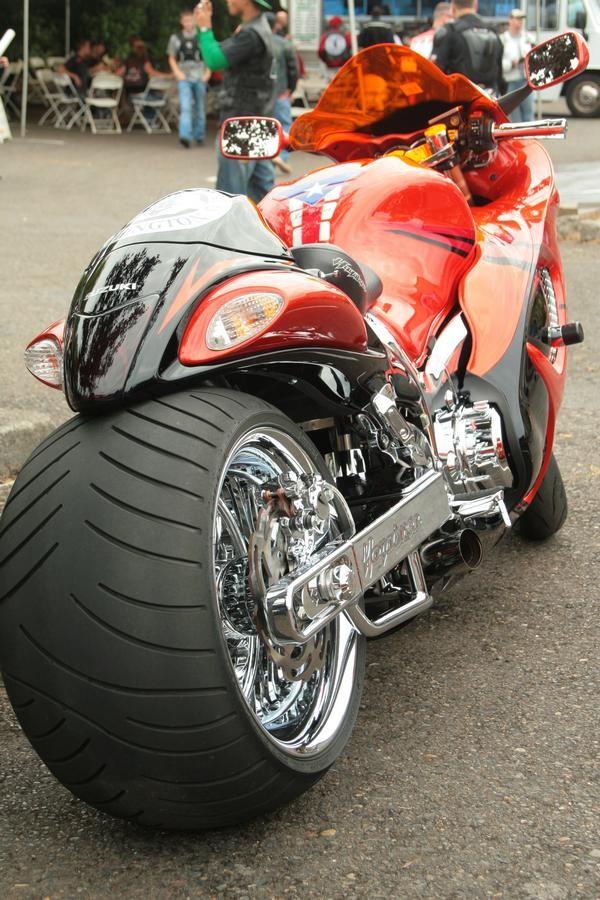 Let's fill in the thematic gaps together.
Let's fill in the thematic gaps together.
Each class of motorcycle has its own type of “shoe”, designed for efficient transmission of torque, better grip, stability when maneuvering in the conditions in which a particular bike is most of its life. Conventionally, motorcycle tires can be divided into road, off-road and racing. Within the class, tires are divided according to tasks: road, slick, rain, cross (endur), mud, studded, and dual-use. Diameter and width - depend on the class and dimensions of the equipment. By class, we will consider it.
In this category, most of the products are designed for limited use and have an extremely small resource - just one race or training session. Provides the best grip on asphalt. Their profile allows you to lay the bike almost parallel to the ground in the turn, however, only after warming up.
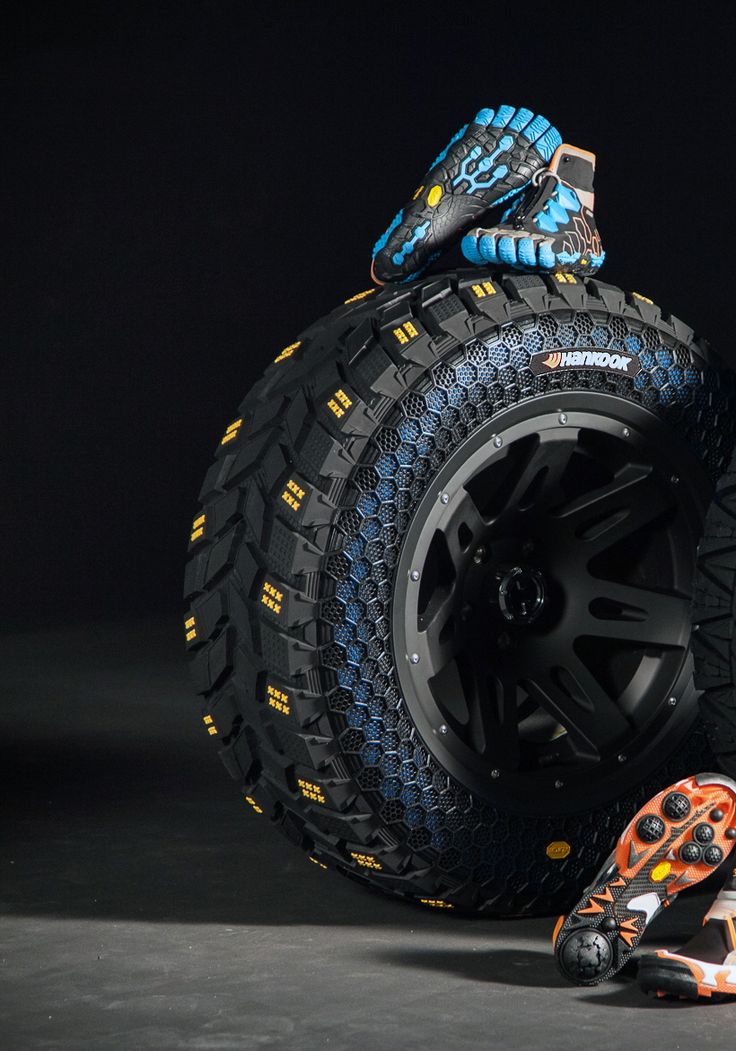 Specialized products for professional sports. They enter the operating mode only when warming up to 90–100 o C.
Specialized products for professional sports. They enter the operating mode only when warming up to 90–100 o C.  Used for everyday riding with infrequent trips to the track "on their own".
Used for everyday riding with infrequent trips to the track "on their own". These motorcycles mostly "live" on the track, observing the primer only from a distance, from the height of the main road, so their "shoes" are designed for asphalt: the most durable, designed for the heavy weight of the motorcycle (passenger + luggage), and "all-weather".
 They allow you to "play enduro" on the classics.
They allow you to "play enduro" on the classics. The scatter of equipment in this category is very large - from "evil" tuned fifty dollars for mini-cross to light enduro for travel, so there are a lot of models here. You can combine them into classes according to their purpose: purely sports, amateur and rally:
 Motorcycle tires for sports, prohibited for DOP. The tread lug is the highest off-road. The line is very hard, designed for aggressive landings. There are a lot of options for drawing and dimension. Typical for loose soil - more rigid and rare lugs, for hard - softer, wider.
Motorcycle tires for sports, prohibited for DOP. The tread lug is the highest off-road. The line is very hard, designed for aggressive landings. There are a lot of options for drawing and dimension. Typical for loose soil - more rigid and rare lugs, for hard - softer, wider. For medium-sized classics, small-capacity, retro and custom motorcycles, various road tires are produced with a low semicircular profile, moderately developed tread, revealing working properties at temperatures below 80 about C. There are a lot of options, as well as specifics (all-season, rain, universal).
Motor tires are designed for high side loads. Its profile - even for the widest models - is more rounded than that of an automobile, consists of a working part responsible for traction, and a side part that “works” only when tilted in a turn. Parts not in contact with asphalt are also very important.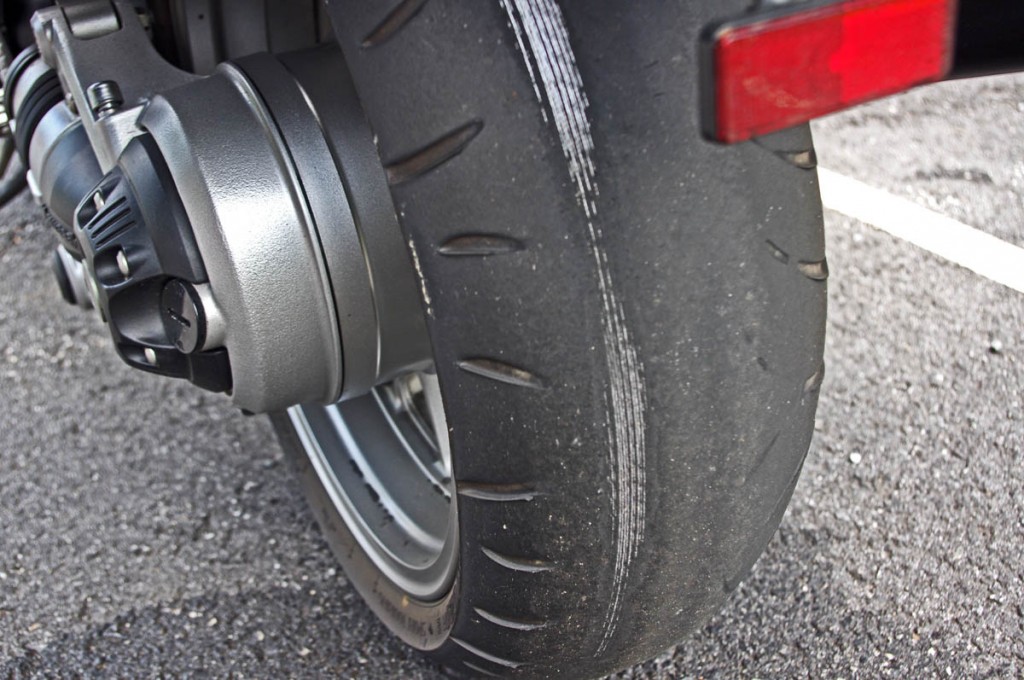 It depends on them how much the tire will weigh, how much it will be washed under the weight of the bike, how long it will last.
It depends on them how much the tire will weigh, how much it will be washed under the weight of the bike, how long it will last.
Hidden part between the inner and outer layers of rubber, which gives rigidity and takes on the load. The structure of the cord is multi-layered. Steel wire, or threads made of polyamide, aramid fibers (Kevlar), or polyamide are arranged in dense rows either across the tire, or - intersect at an angle of 30–40 degrees in the direction of its rotation.
The edge of the tire, going inward, into the grooves of the edges of the rim, having an annular metal (internal) reinforcement. The reliability of its fixation in the rim determines the life of a motorcycle tire, and sometimes a motorcycle with a driver.
The working part, covered with an intricate pattern, the size, shape and depth of the grooves of which depend on the purpose of the product.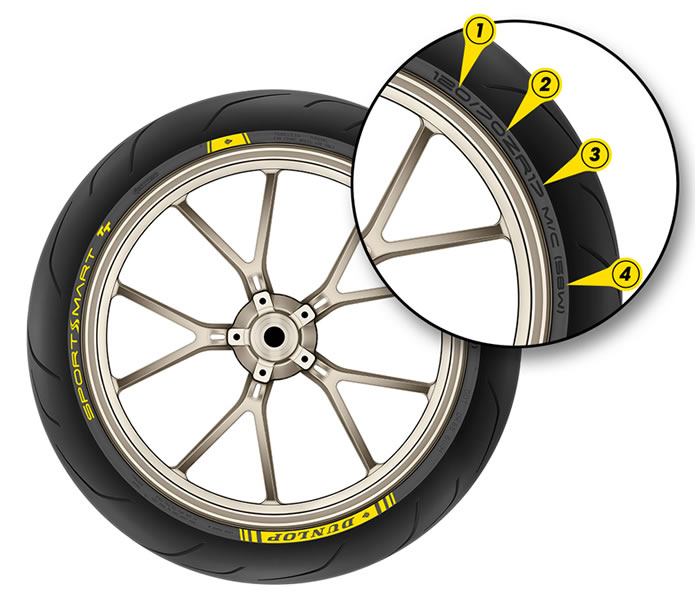 A larger high tread is typical for off-road and cross-country motor tires, a lower, smooth one - for road and racing.
A larger high tread is typical for off-road and cross-country motor tires, a lower, smooth one - for road and racing.
A zone connecting the tread and the bead that is not inferior to them in strength, but does not work with either the road surface or the rim. It is on it that “letters” are applied that reveal the properties and characteristics of the tire.
The three main indicators of motor rubber - width, profile (height), seat diameter (internal) - are measured in millimeters and inches. There are about a dozen markings adopted in different countries, but only four systems are widely used: Metric, Alpha, Standard (inch), Low profile (inch). For each of them, corresponding tables are available. For our market, more characteristically - Metric.
The name of the manufacturer (brand) and the name of the model are written in the largest letters on the product.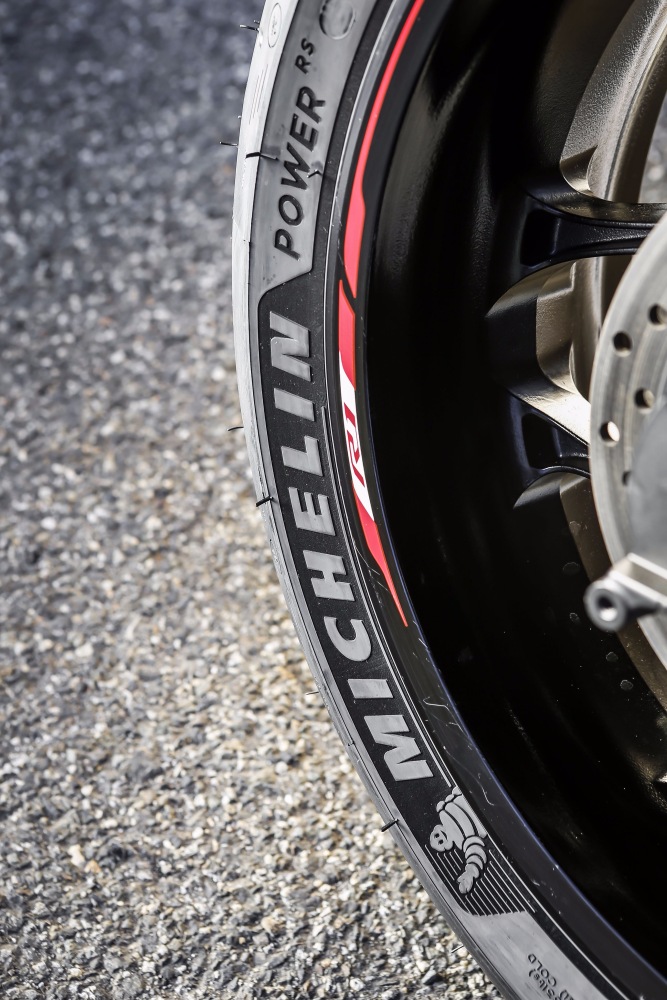 The next in size is a "sausage" of numbers and Latin letters, indicating the width, height of the profile, the diameter of the rim for which the tire is intended, the weight limit per axle (rear / front), and the speed to which you can accelerate on this rubber. A little smaller - the country of origin, certificate, information about the material, design. Further, “small print” indicates no less important properties, which we will also consider separately.
The next in size is a "sausage" of numbers and Latin letters, indicating the width, height of the profile, the diameter of the rim for which the tire is intended, the weight limit per axle (rear / front), and the speed to which you can accelerate on this rubber. A little smaller - the country of origin, certificate, information about the material, design. Further, “small print” indicates no less important properties, which we will also consider separately.
I’ll immediately note the most common mistake in reading the rubber size index: the letter R is not a “radius”, as some motorcycle and car owners believe. This letter means "radial" model and indicates the radial direction of the inner carcass reinforcing layers of this tire. There are two main designs - radial - when the cord layers run across the tire, and diagonal - when they cross.
You don’t see the letter “R” in the index, but you see a gap, or “B” - it means the rubber is diagonal, and if “reinforced” or “reinf” is written nearby, it is also reinforced with an additional layer of cord.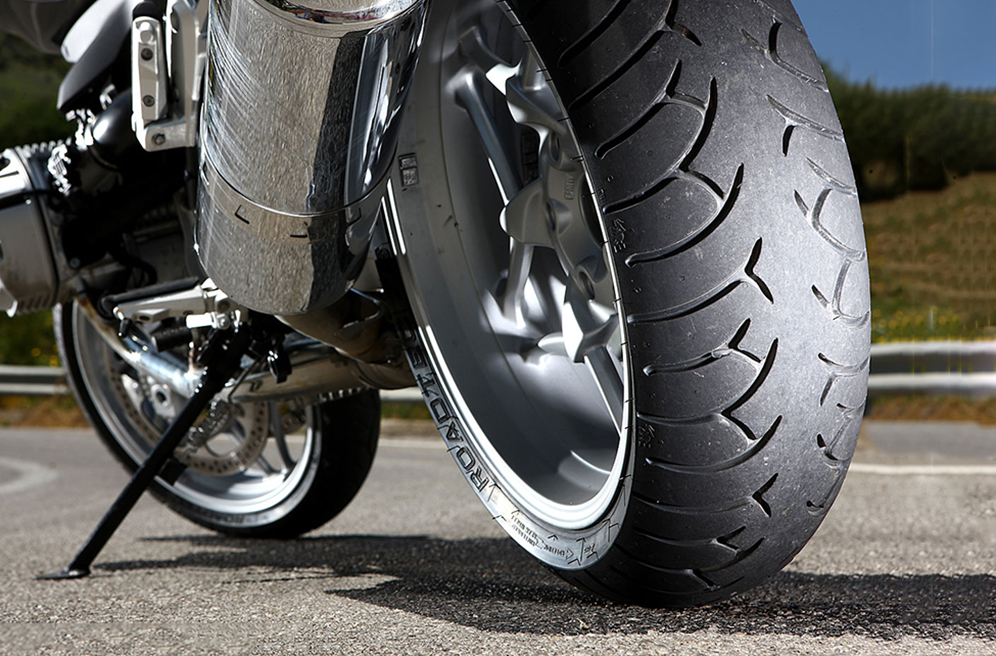
"Sausage of letters and numbers", for example, 120/70 ZR17 (73W) TL, stands for:
The arrow with the words "wheel rotation" strictly regulates where the tire should rotate during operation. If there are letters ND (non directional) on board, it can be placed in any direction.
If the manufacturer clearly limits the installation location of the tire, he writes “Front” on it for the front or “Rear” for the rear.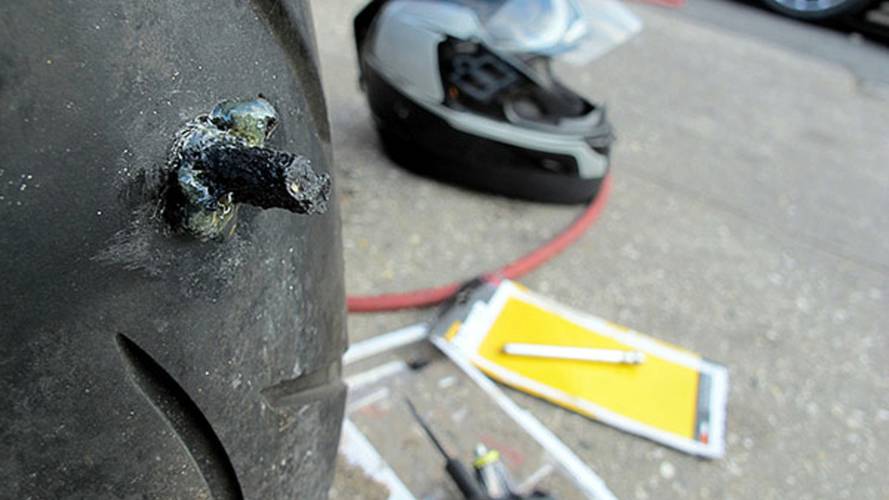 Without this marking, rubber can be placed on either side.
Without this marking, rubber can be placed on either side.
TL or tube less - as we have already deciphered earlier - tubeless. TT stands for tube type, or "suitable for camera use."
All manufacturers unanimously recommend “not wearing” rubber for more than five years, and if the equipment has been “shod” in it for ten years, even mothballed, urgently change the “bagels” without hesitation. A couple of decades ago, the resource of tires was regulated only by their external condition and the courage of the driver, but this was even before the mass “epidemic of planned obsolescence of goods”. Now, two years are taken into account in the calculation of the service life, and five years is the allowable storage period for rubber in a warehouse, as a result of which it should not be sold, but disposed of. The release date is marked with two two-digit numbers enclosed in a circle or oval. The first is the week number from the beginning of the year, the second is the year of production itself.
Now, two years are taken into account in the calculation of the service life, and five years is the allowable storage period for rubber in a warehouse, as a result of which it should not be sold, but disposed of. The release date is marked with two two-digit numbers enclosed in a circle or oval. The first is the week number from the beginning of the year, the second is the year of production itself.
It is a common practice to buy lightly worn race slicks or cuts - only makes sense for training on the "ring" or karting track, but not on the DOP. In addition to poor handling, longer stopping distances on slippery surfaces, and increased risk of blown tires at high speeds, riding old tires carries legal risks. When passing a technical inspection, a cracked or worn protector (hypothetically) can cause a refusal to issue a diagnostic card. In fact, this is the same malfunction as badly worn brake pads. Also, in the event of an accident, due to the unsatisfactory condition of the rubber, the insurance company may refuse to pay you, referring to your favorite excuse - speeding (based on the increased stopping distance).
"From the factory" modern motorcycle tires are covered with a preservative silicone impregnation that prevents drying out during storage. It is slippery and penetrates deep into the pores of the rubber. Until you wipe it on the asphalt - do not count on a good "hold" and "sharp" brakes. It is not necessary to wash off the grease with gasoline or other solvent (it is useless), just ride measuredly for the first couple of hundred kilometers. By the way, after long-term storage of used road motor rubber, it is also recommended to “run in” it in order to remove a layer of coarsened material from the surface.
Even if you provide ideal storage conditions, motor rubber still ages over time, becoming covered with microcracks. If the "age" of tires has exceeded 10 years or more - do not buy them, despite their attractive appearance.
Signs of critical wear:
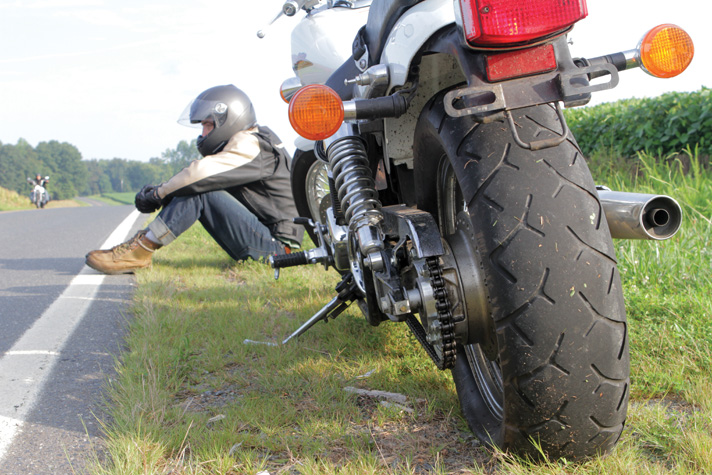
The principle of evaluating the residual depth of the tread grooves is now outdated - most manufacturers add an integrated tire wear indicator to the options, which is worth focusing on.
Let's start with what happens if you put a wider tire back without changing the "native" rim. This question worries many inexperienced motorcyclists who want to look more "sporty".
Firstly, you will not wait for the expected increase in traction due to the increased area of \u200b\u200b"support".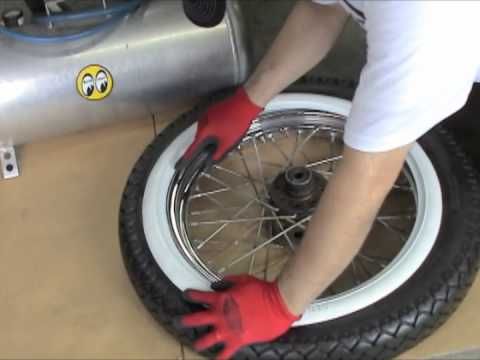 Wider rubber, squeezed by the edges of the rim not in size, will tend to “up”, so the calculated wheel profile will be violated. It will be higher, respectively, the contact patch will not increase. Secondly, the controllability in corners will worsen, the speedometer will “lie”, the weight distribution will change due to the rear of the motorcycle raised.
Wider rubber, squeezed by the edges of the rim not in size, will tend to “up”, so the calculated wheel profile will be violated. It will be higher, respectively, the contact patch will not increase. Secondly, the controllability in corners will worsen, the speedometer will “lie”, the weight distribution will change due to the rear of the motorcycle raised.
This is highly discouraged for most modern sportbikes that hit the track, but many classic models, nakeds and cruisers are often fitted from the factory with a combination of radial front and diagonal rear tires. Unlike the radial, the diagonal one is a little “softer”, allows for moderate overload, is sold a little cheaper, so why not?
The choice of how much to inflate the wheels to is a constant compromise between the loads on the rubber and its capabilities. On most motorcycles, the recommended pressure for each axle is indicated on a sticker (on the fork and swingarm), but this value is only relevant for the rubber model that was supplied from the factory. On a new model, look for a designation on the tire (next to the max load load) indicating the maximum allowable cold pressure. Do not take a tire if this value is lower than recommended for your motorcycle.
On most motorcycles, the recommended pressure for each axle is indicated on a sticker (on the fork and swingarm), but this value is only relevant for the rubber model that was supplied from the factory. On a new model, look for a designation on the tire (next to the max load load) indicating the maximum allowable cold pressure. Do not take a tire if this value is lower than recommended for your motorcycle.
Let's say your bike has a sticker with the recommended 2.25 bar for the front and 2.5 bar for the rear wheel. If you ride mainly with a passenger, with luggage, making long “flights” along the track, your motorcycle weighs 200 or more kilograms, and its volume is close to a liter, keep the pressure in the rear wheel at least 2.8–3.0 bar, and in the front 2.5 bar. If you ride around the city, alone, with almost no luggage, and are not fond of “flights”, it would be optimal to set equal pressure in both wheels at 2.2 bar.
For lightly loaded medium-sized engines, the interval varies from 2. 0 to 2.3 bar, and for slender "Chinese" 2.1 bar - in the front, 1.9 bar - in the rear cylinder (especially if the tires are also Chinese). The pressure in road tires must not be lowered below 1.9 so that the motorcycle does not start to “float” in corners or on bumps - this is dangerous.
0 to 2.3 bar, and for slender "Chinese" 2.1 bar - in the front, 1.9 bar - in the rear cylinder (especially if the tires are also Chinese). The pressure in road tires must not be lowered below 1.9 so that the motorcycle does not start to “float” in corners or on bumps - this is dangerous.
The more we inflate the closed volume of the wheel, the more “round” it becomes and the smaller the area in contact with the asphalt. A larger contact patch means greater rolling resistance and accelerated tire wear, a smaller one means worse stability, lower braking and acceleration efficiency. Up to a certain point, these nuances are compensated by the tread, so on motocross and enduro bikes, the wheels can be lowered to 1.2 bar - front and 0.8 bar - rear. However, air is an unreliable business, therefore, in hard enduro and trials, a gel filler is now more often used, which allows maintaining a pressure of 0.4 and 0.9bar. Such a set will not live long, but this is a sport in which, as we remember, rubber consumption is not considered.
Definitely yes. The older the cylinder, the harder its surface and the lower the residual tread height, the worse the bike “holds” the road. Bald or improperly matched tires increase the braking distance, and can cause an unexpected “leaving” the track into a ditch. On an over-inflated tire, the fork or pendulum will “beat” hard, and on a flat tire, the motorcycle will become less predictable in corners and “gobble up” more gasoline than in a normal ride.
No, because their rims are not sealed and you simply cannot inflate the tire. Not all alloy wheels are suitable for tubeless, so always check what type of rubber was on the bike before. In addition, the hole in the rim designed for the camera nipple may not match the size of the new nipple.
Only if the damage to the wheel does not allow you to inflate the tire, and you still need to get to the “repair”. In all other cases, the idea is controversial. The inner surface of a tubeless rim is not designed for other rubber to constantly rub against it, creating additional heating, and the inner part of a tubeless rim may have protrusions that injure the chamber. It is possible to get a “beautiful” wheel by putting a tubeless tube on a spoked rim, but objectively, this will increase its weight (remember the unsprung masses), and reduce the life of the camera. About when it frays to break - you will know already on a flat tire. You can repair a puncture of a tubeless tire without removing the wheel, but you will have to remove and patch the tube with its disassembly.
In all other cases, the idea is controversial. The inner surface of a tubeless rim is not designed for other rubber to constantly rub against it, creating additional heating, and the inner part of a tubeless rim may have protrusions that injure the chamber. It is possible to get a “beautiful” wheel by putting a tubeless tube on a spoked rim, but objectively, this will increase its weight (remember the unsprung masses), and reduce the life of the camera. About when it frays to break - you will know already on a flat tire. You can repair a puncture of a tubeless tire without removing the wheel, but you will have to remove and patch the tube with its disassembly.
Undesirable. Even if it does not look worn yet, its resource is already less, from frequent “heating-cooling” cycles, it becomes rougher than new, frays or cracks faster. The old tube may not fully expand and fold if the new rubber has a lower profile (and internal volume) than the previous one.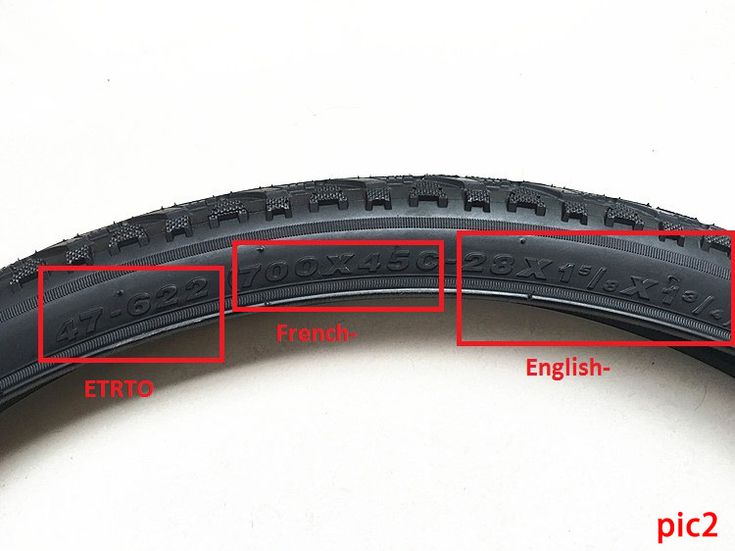
If it belongs to the Racing Street or Street Legal class, this is a completely justified choice for the owner of a sport, street, naked or classic with claims to “aggressiveness”. In other cases, it is not recommended. Firstly, the use of racing slicks or cross-country tires is not allowed on the DOP. Secondly, sports tires are designed for intensive work with a certain warm-up. At competitions, before the race, they are warmed up in special covers, and then they are “given” one warm-up lap so that from the first seconds of the test race they can provide the bike with good contact with the asphalt (sticking).
In the city, even if you ride aggressively, the slick simply does not have time to warm up to operating temperature (more than 80 about C). Or even before it does not heat up for the whole trip, given the ragged rhythm of traffic lights and possible "toffees". Accordingly, it will not give adequate grip when trying to “give a corner”, the wheels will be demolished during braking, and instead of an energetic start, the bike will “grind” on the spot.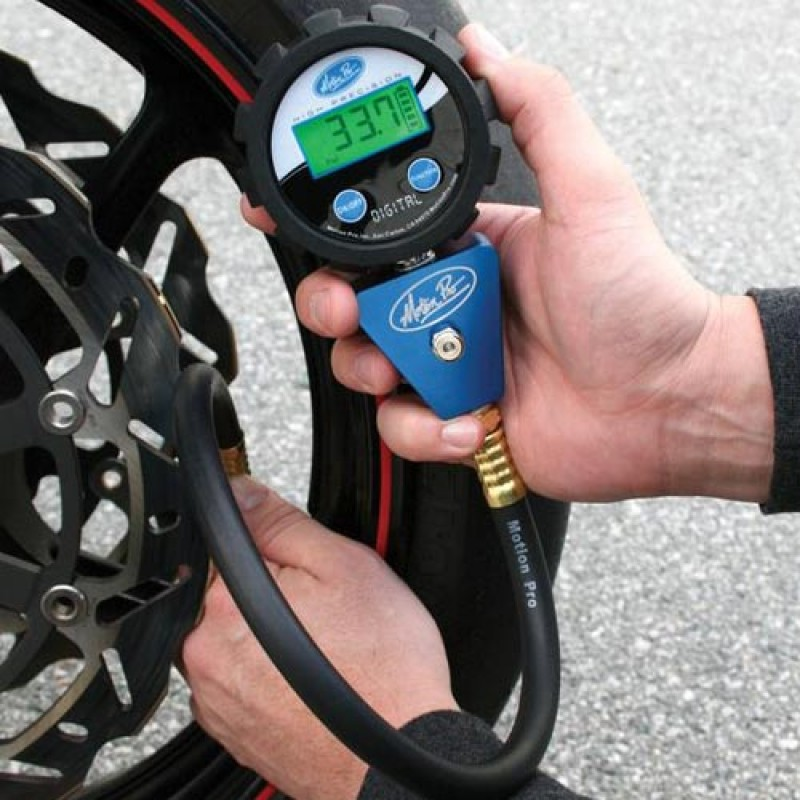
Ideally, pre-washed, treated with a silicone spray, complete with a disk and in special cases. Naturally - in a dry, dark place with a constant temperature, away from fire, children and animals.
Change your shoes for the winter, or find and set aside good rubber in reserve - make sure that during storage it:
Few people can provide all these conditions, so remember at least the main thing: protect the motor rubber from drying out and deformation - do not hang it, but lay it horizontally, wrapped in waterproof fabric.
This is only the main part of the answers to popular questions about motorcycle tires, collected in one material. Without "deepening" in the topic - a little about everything. If any of your questions still remain unanswered - ask it in the comments, we will definitely analyze it.
If any of your questions still remain unanswered - ask it in the comments, we will definitely analyze it.
Hello everyone, Pitbike club with you!
So that newbies and amateurs in our motorcycle fraternity don't get confused in terms, we have prepared a little background on the general differences between motorcycle tires.
What kind of motorcycle tires are there? What are they for?
All motorcycle tires are divided into 4 broad groups: slicks, road tires, dual purpose tires and off road tires.
1. Slicks are solid tires designed primarily for race track use on dry, prepared asphalt. Tires of this type provide the maximum contact patch, withstand maximum speeds. Slicks are uncompromising tires. They are not threaded and are not recommended for off-track use or on heavy motorcycles. The downside is performance - rubber is designed for use on dry asphalt, wears out quickly and often requires preheating.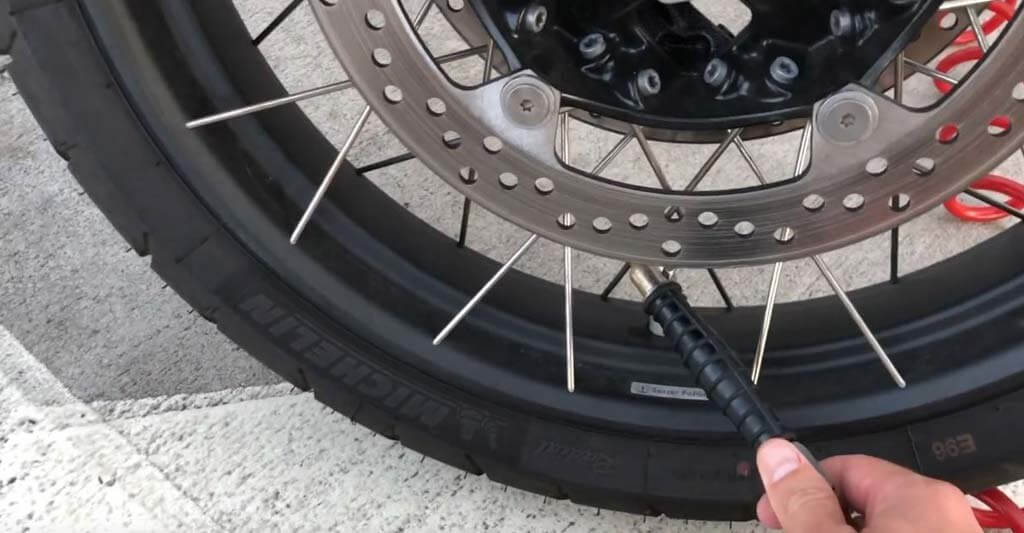 Externally, this type of rubber is a bit like road tires, but differ in composition. Most often used on track sport bikes and super motos.
Externally, this type of rubber is a bit like road tires, but differ in composition. Most often used on track sport bikes and super motos.
2. Road tires are the largest group. They are cut in the form of drainage channels. Rubber is resistant to wear, does not require long warm-up, behaves steadily in rainy weather. In a word - the best rubber for everyday use. Huge range for every budget. Such tires are ideal for any class of motorcycles, for driving on asphalt in almost any weather, at positive temperatures.
3. Dual purpose tires - a cross between road and off-road tires. It differs from the road one in a more aggressive tread. However, the contact patch on asphalt is immediately reduced. The profile is similar to that of a road tire, but the grooves are deeper and more reminiscent of spikes than the tread pattern of ordinary road rubber. Such tires on asphalt wear out faster than usual, as they are softer. This is a price to pay for the opportunity to use these tires not only on the road, but also beyond.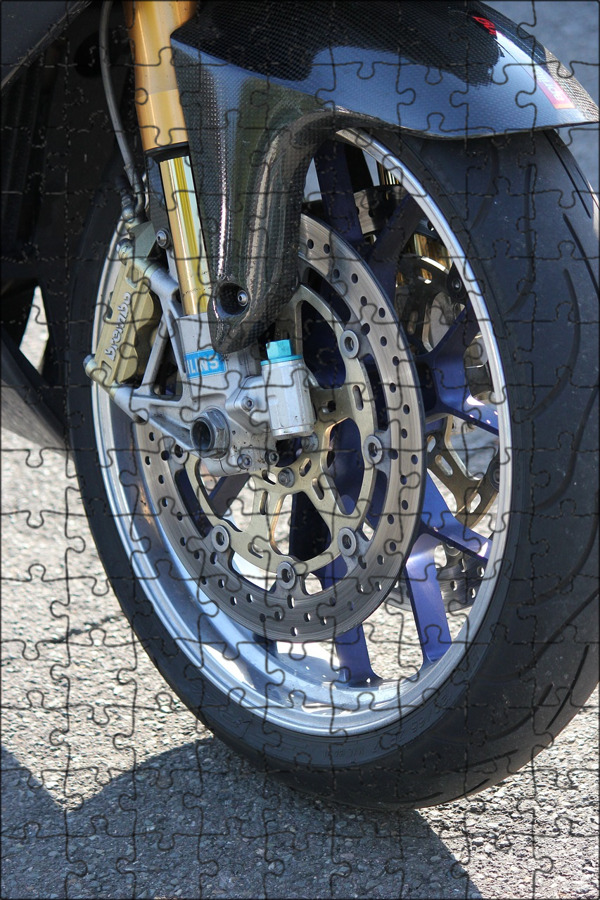 Ideal for motards and touring enduros who regularly travel off the asphalt road.
Ideal for motards and touring enduros who regularly travel off the asphalt road.
4. Off-road tires are not like conventional road tires. Outwardly, it resembles slicks, on which square spikes are installed. These tires are designed exclusively for off-road driving. This is due to the fact that the rubber is not controlled on asphalt - the contact patch is very small, there is not enough hook. Due to the high profile, the bike with such tires behaves unstable. And, of course, wear resistance when operating on paved roads leaves much to be desired. Used exclusively on motocross, enduro and moto-trial motorcycles.
Tires, rims, inner tubes, complete wheels — see catalog
And now a few words about towing vehicles.
What is a trailer and what is it for?
A rim lock is a device that holds the tire to the rim to prevent it from spinning while riding. Used in enduro conditions on off-road tires. It consists of a bolt and a special plate attached to it, which is installed between the rim and the tire, opposite the spool.